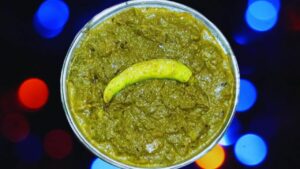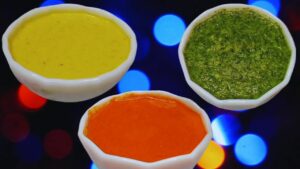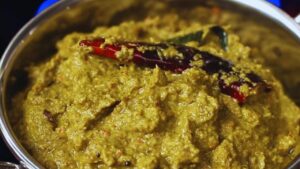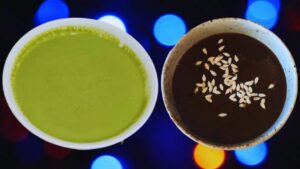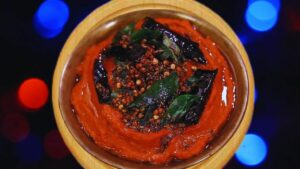Embark on a culinary journey with my delectable dosa chutney recipe, a perfect complement to your crispy dosas.
Elevate your dining experience with two flavorful chutneys: a coconut delight and a zesty onion-tomato fusion.
Each step unfolds with precision, guiding you through the art of creating these tantalizing accompaniments.
Let the aromatic blend of fresh ingredients and expert tips transform your dosa sessions into a gastronomic delight.
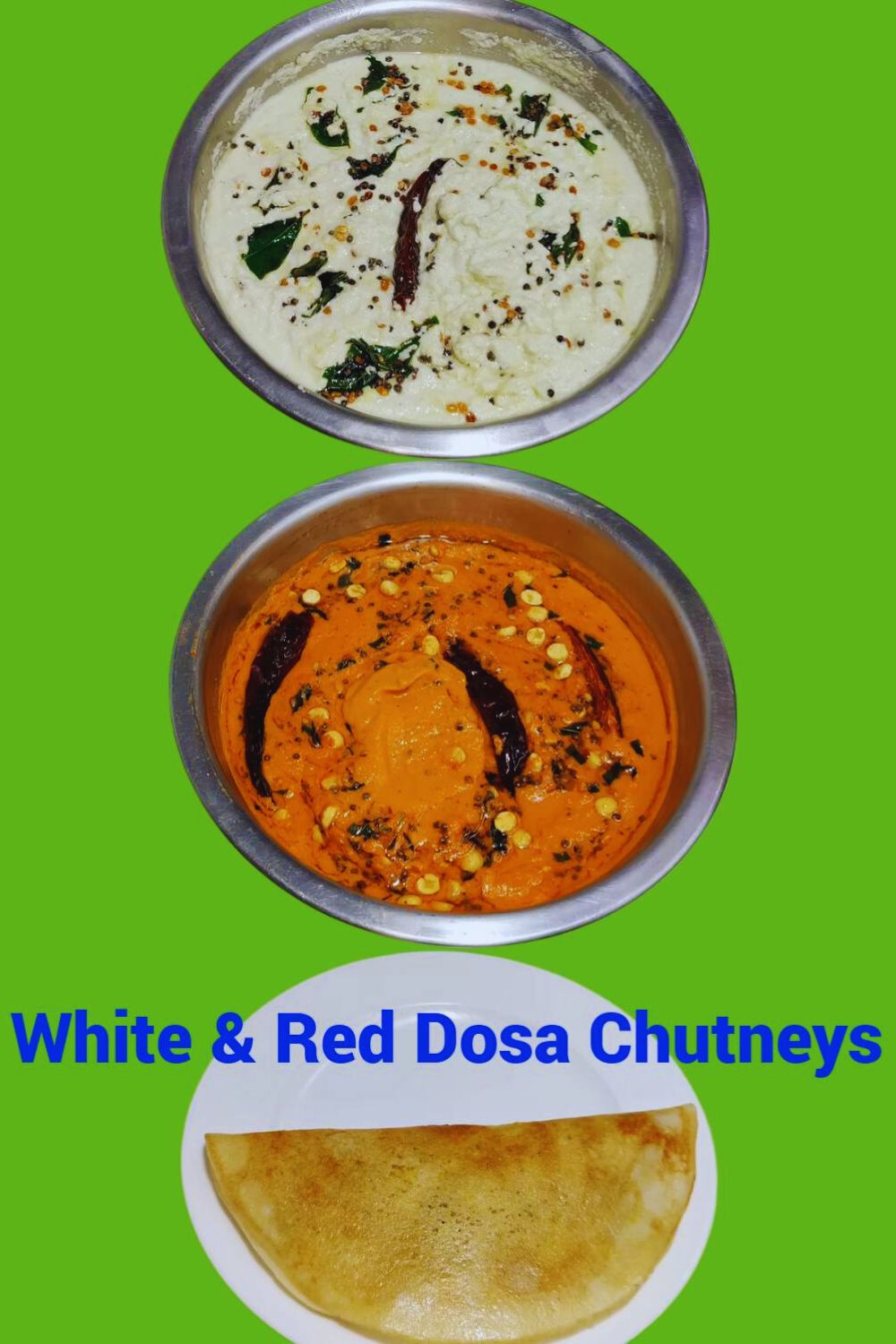
KEY TAKEAWAYS
- Master the art of dosa chutneys with two delectable options – a creamy coconut delight and a zesty onion-tomato fusion.
- Elevate flavors by using fresh ingredients like coconut, curry leaves, and chilies for a vibrant and aromatic experience.
- Preserve the chutneys by refrigerating in airtight containers, and consuming within 3-4 days for optimal freshness.
- Beyond dosas, explore pairing options with idlis, uttapam, vadas, and even as a delightful dip for snacks.
- Experiment with chutney alternatives like mint, tomato-garlic, peanut, coriander, or tamarind to diversify your South Indian culinary journey.
How to Cook Dosa Chutney? (Step by Step Guide with Images)
For Dosa Coconut Chutney:
Step 1: Take a coconut, break the hard shell, and peel the brown skin with a peeler. Cut it into small pieces.
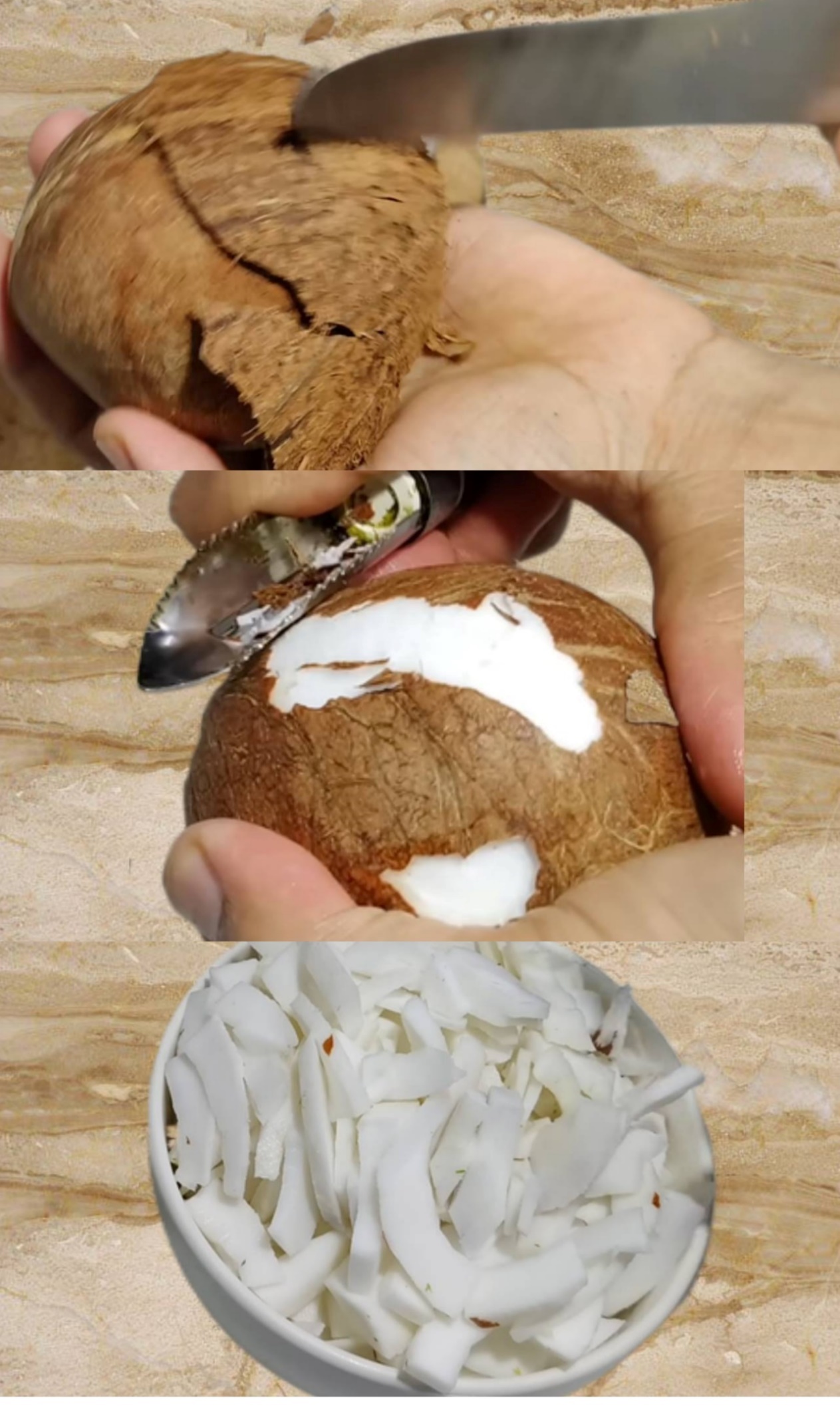
(Expert tip: To break the coconut, keep striking the shell with a hard substance such as a knife. You may also keep it in the freezer for about 20 minutes or heat it on your gas stove. It will come off easily).
Step 2: Take a grinder and put 1 cup of fresh coconut, cut into small slices.
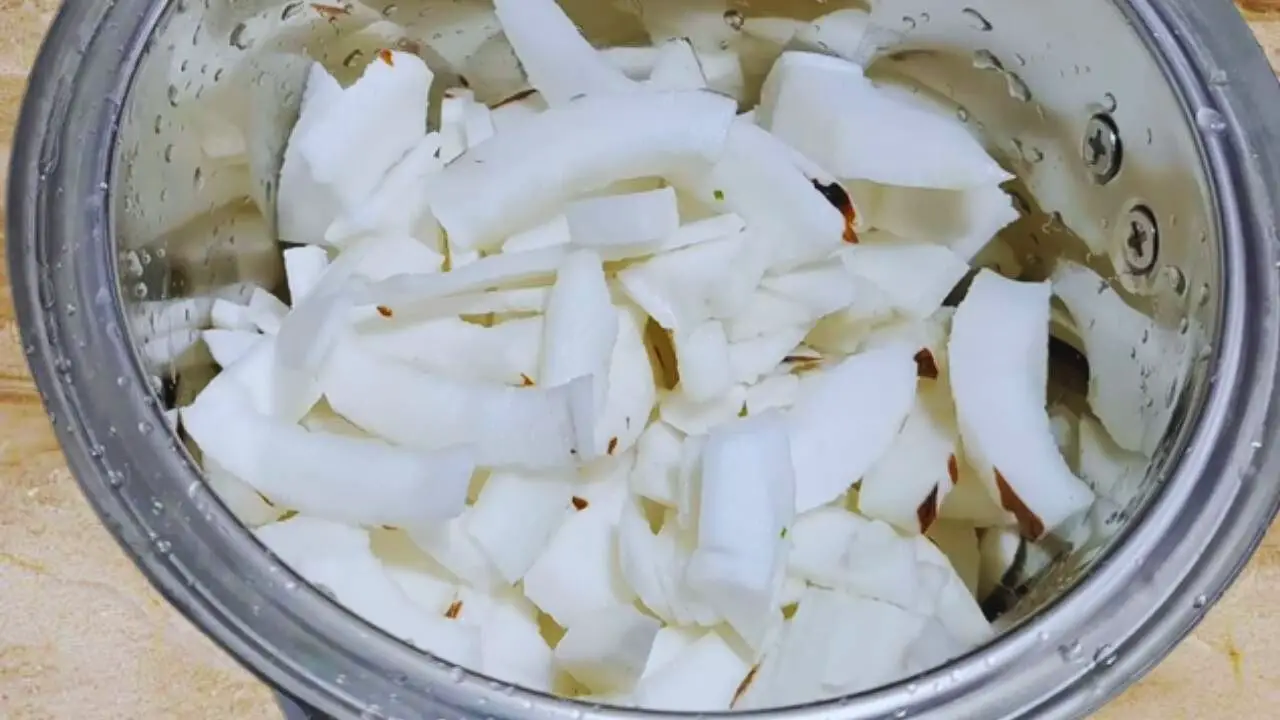
Step 3: Now add about 25 pieces of fresh curry leaves to the grinder.
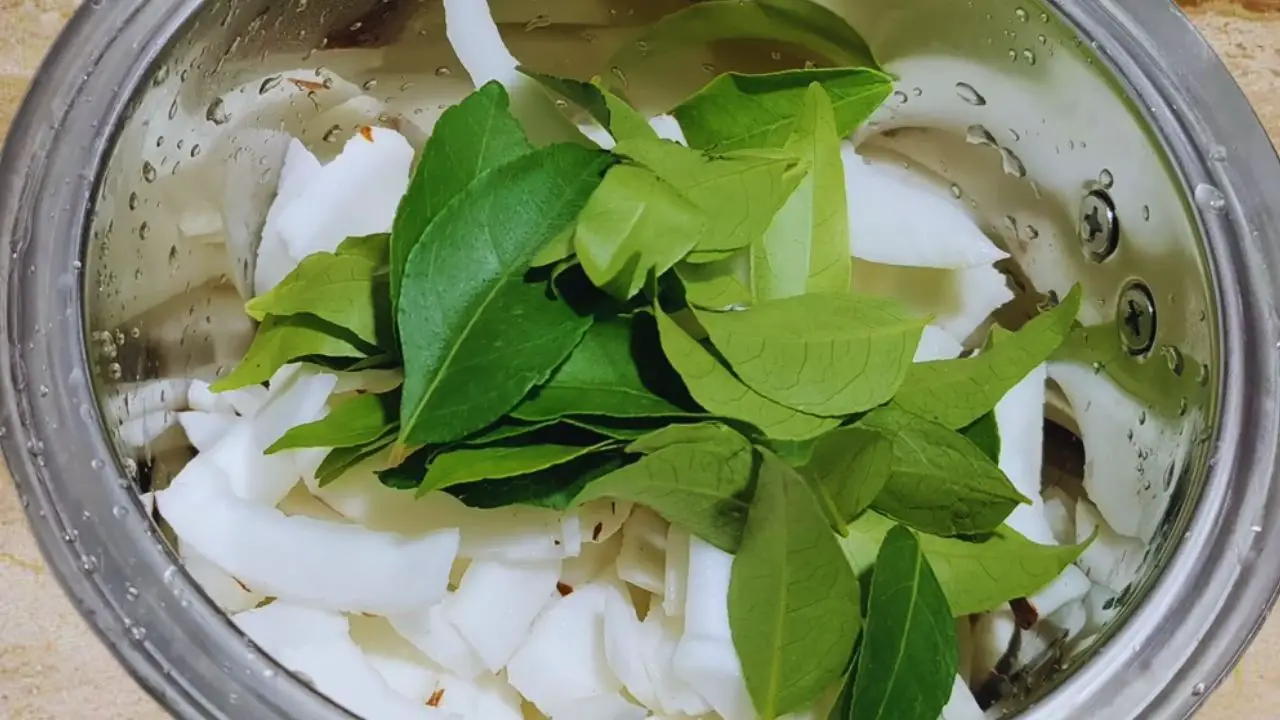
(Expert tip: You may skip adding the curry leaves to the chutney if you do not have it. However, adding them will augment its taste and flavor).
Step 4: Follow it with 2 pieces of fresh green chilies of standard size.
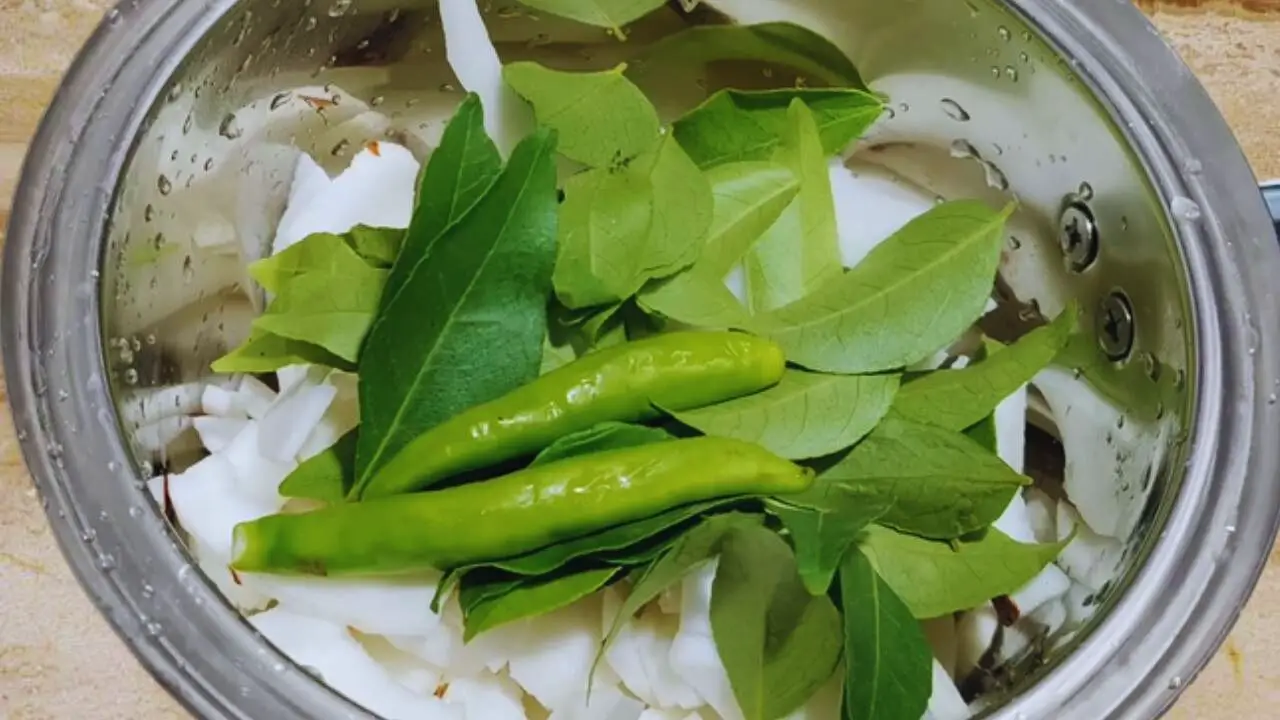
Step 5: Then add 1 piece of 1-inch size ginger, deskinned and sliced.
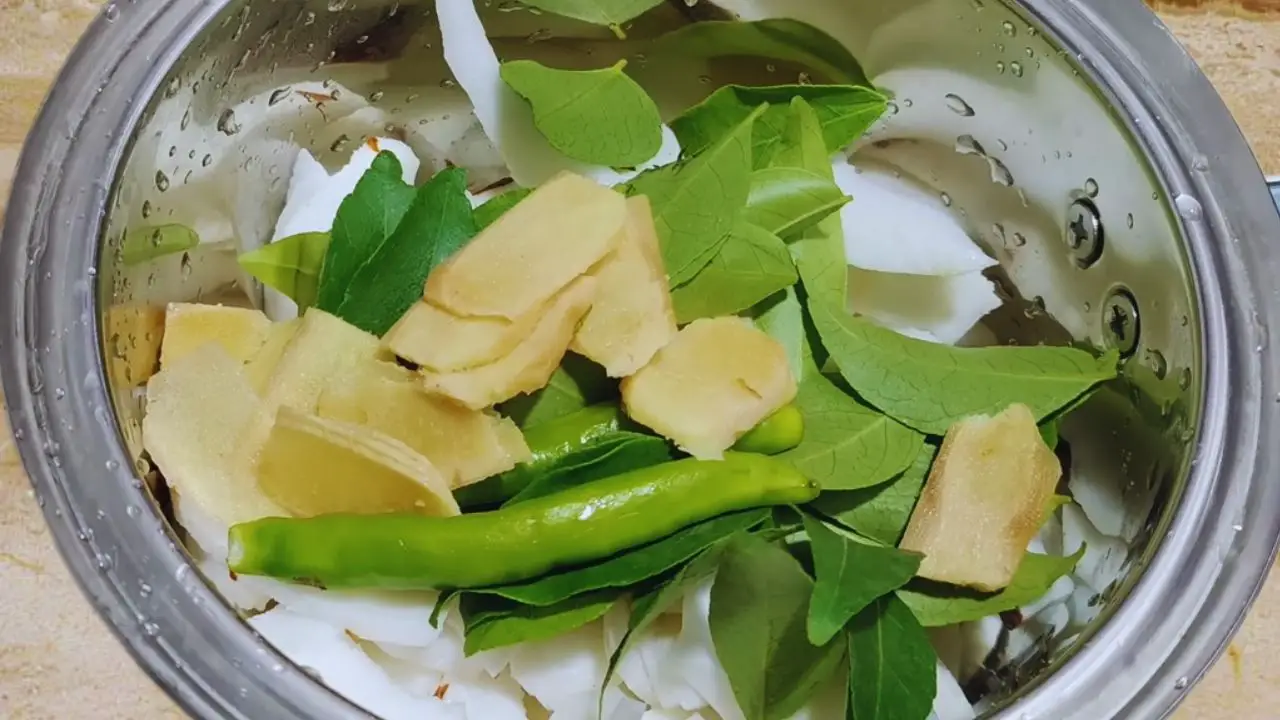
Step 6: Follow it with 2 tbsp of roasted split chickpeas (chana dal) to the content in the grinder.
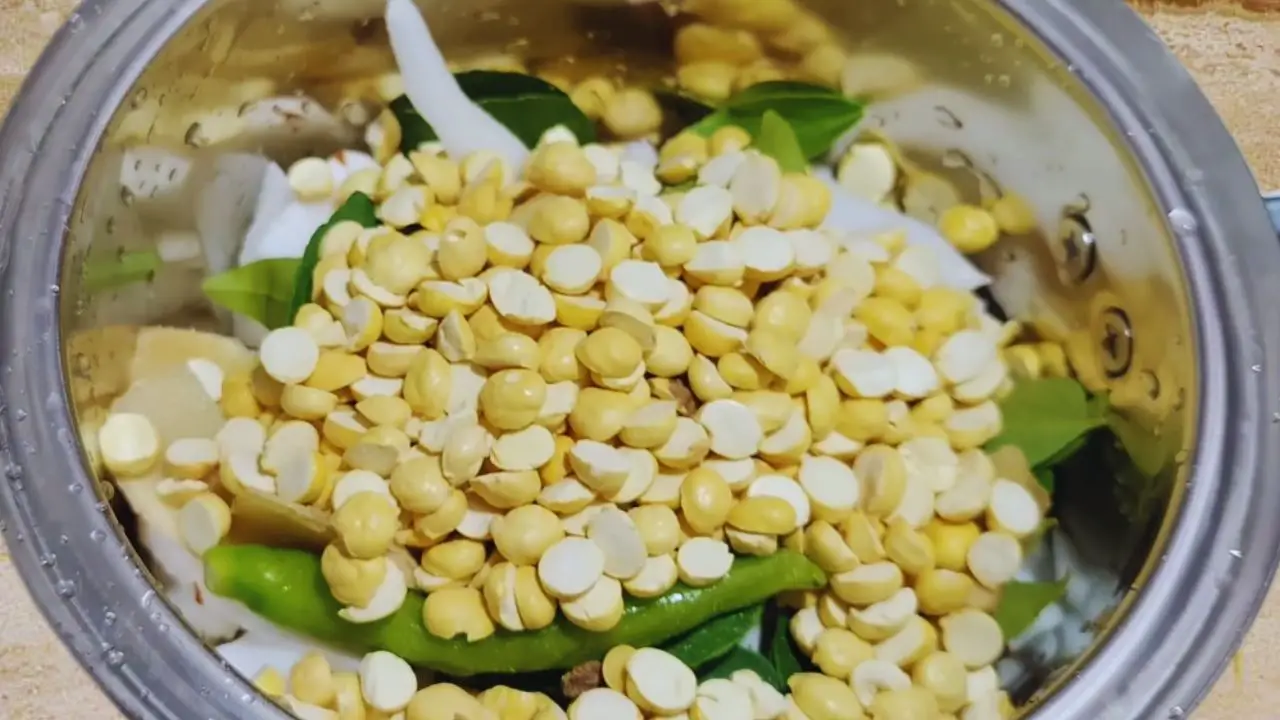
Step 7: Now take a frying pan and heat it on a low flame on your gas stove. Pour 2 cups of milk into it.
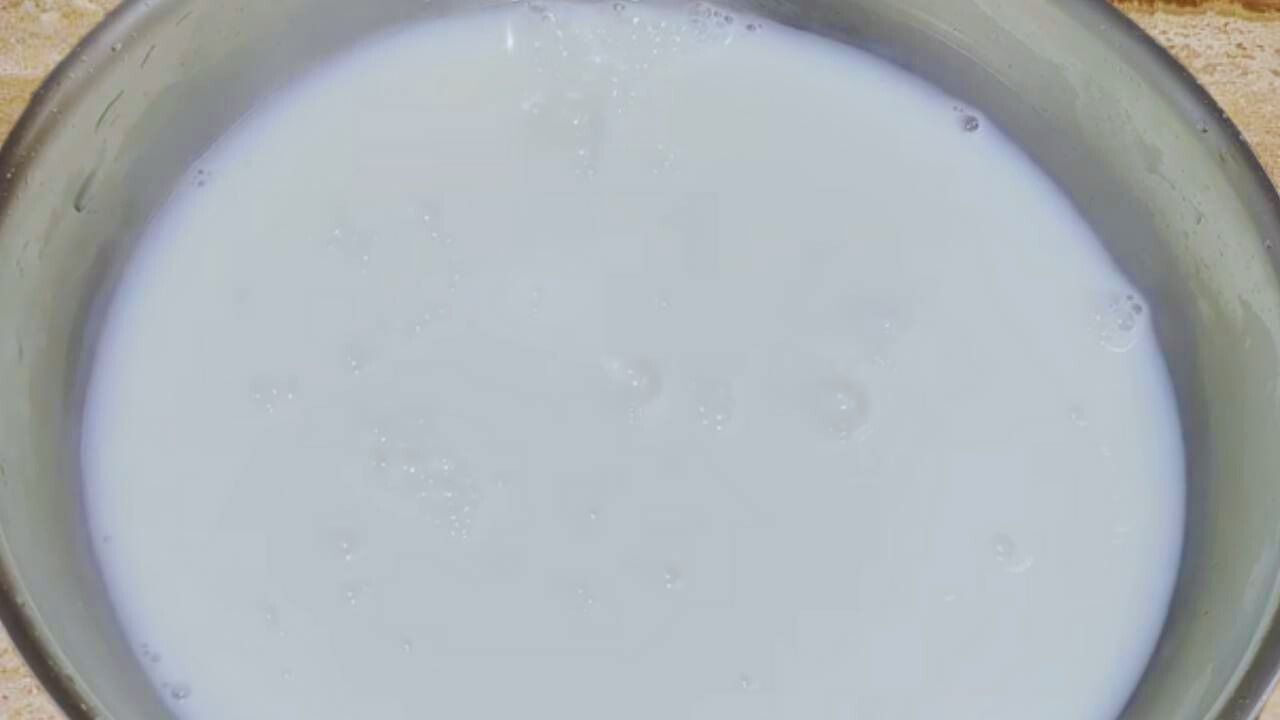
Step 8: Warm the milk just a bit. Put your finger to feel the warmth.
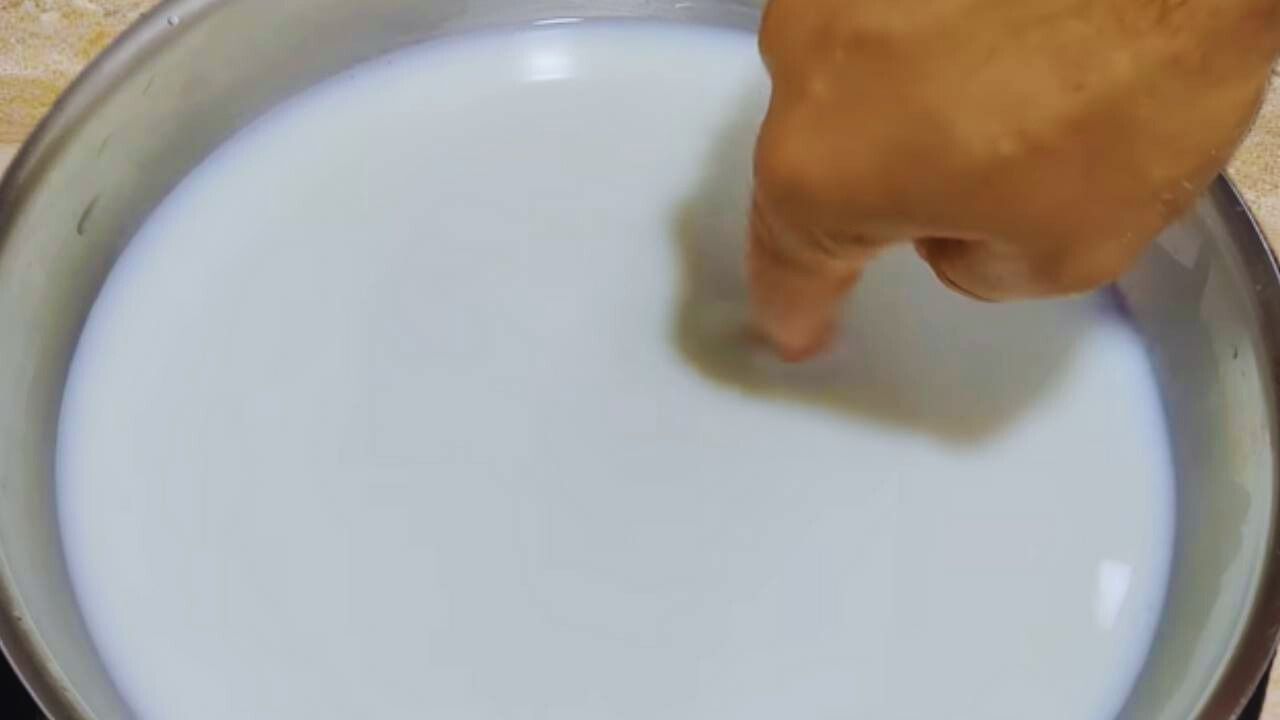
(Expert tip: Use milk that you boiled before. Do not boil the milk now).
Step 9: Pour the warm milk into the grinder.
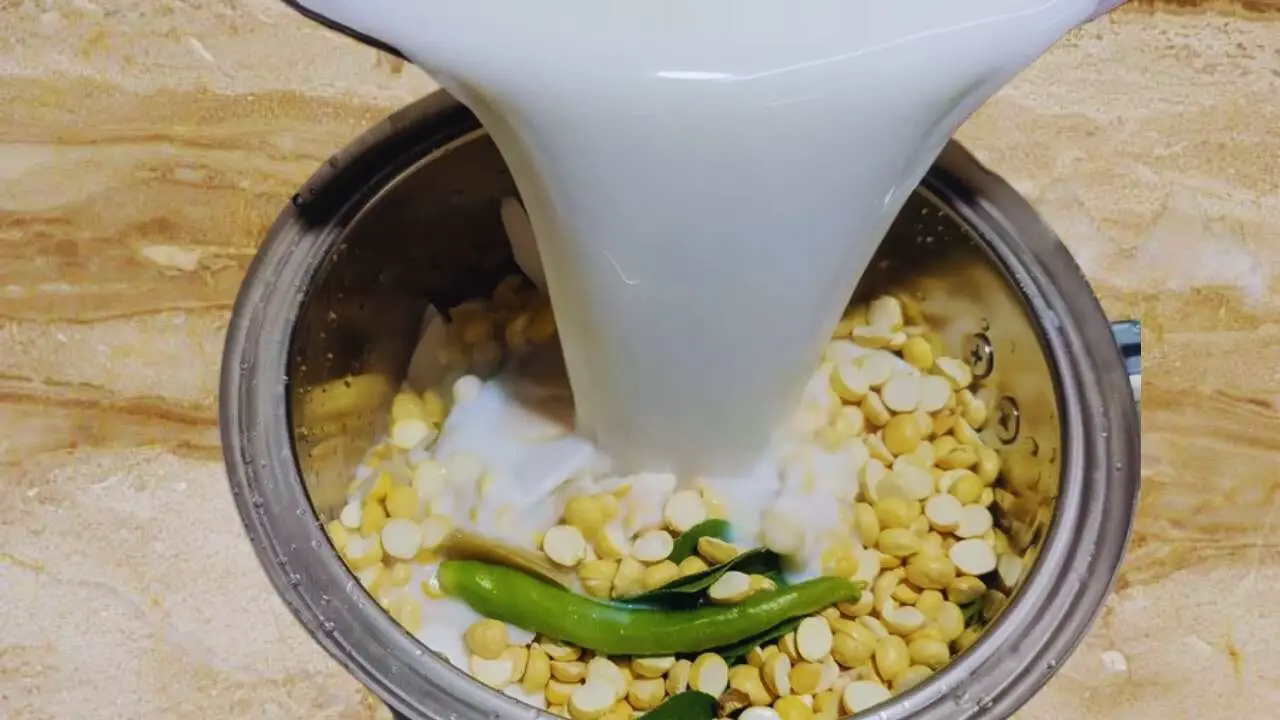
(Expert tip: If you do not like milk, you can use normal water or the water of the coconut used in this recipe. However, adding milk adds to the color and taste of the chutney).
Step 10: Grind everything into a fine paste.
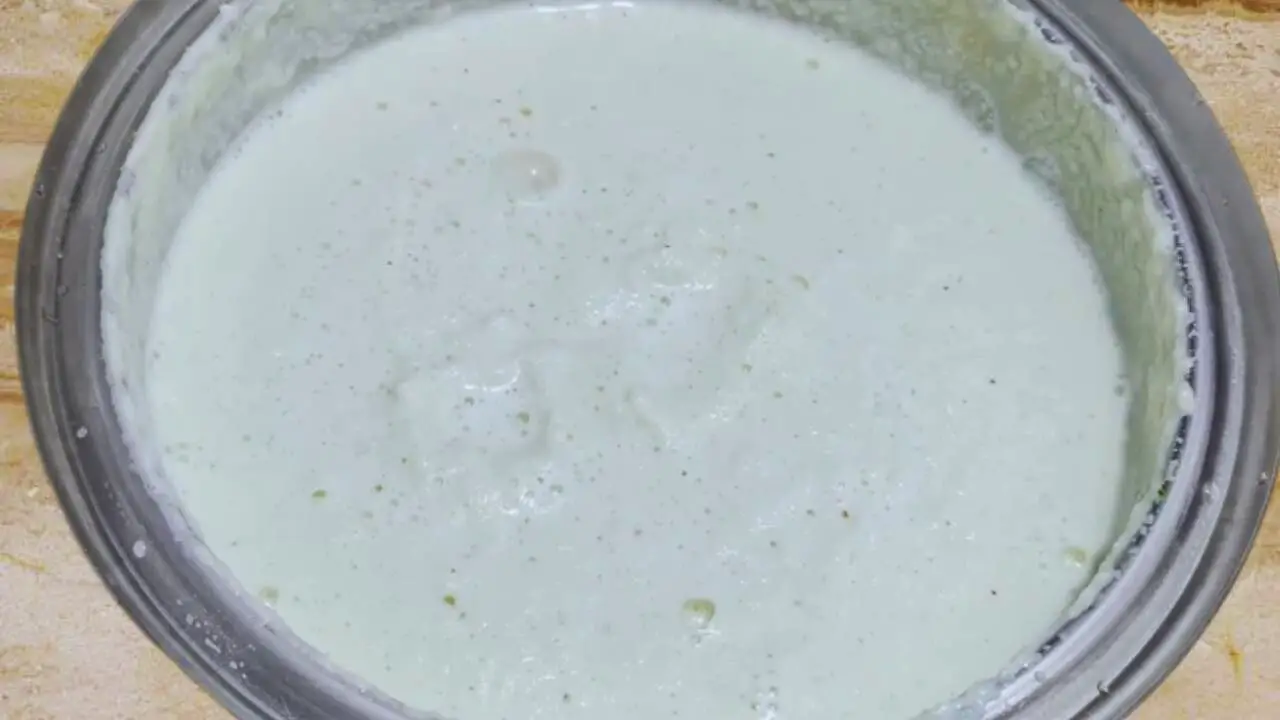
Step 11: Transfer the paste into a bowl.
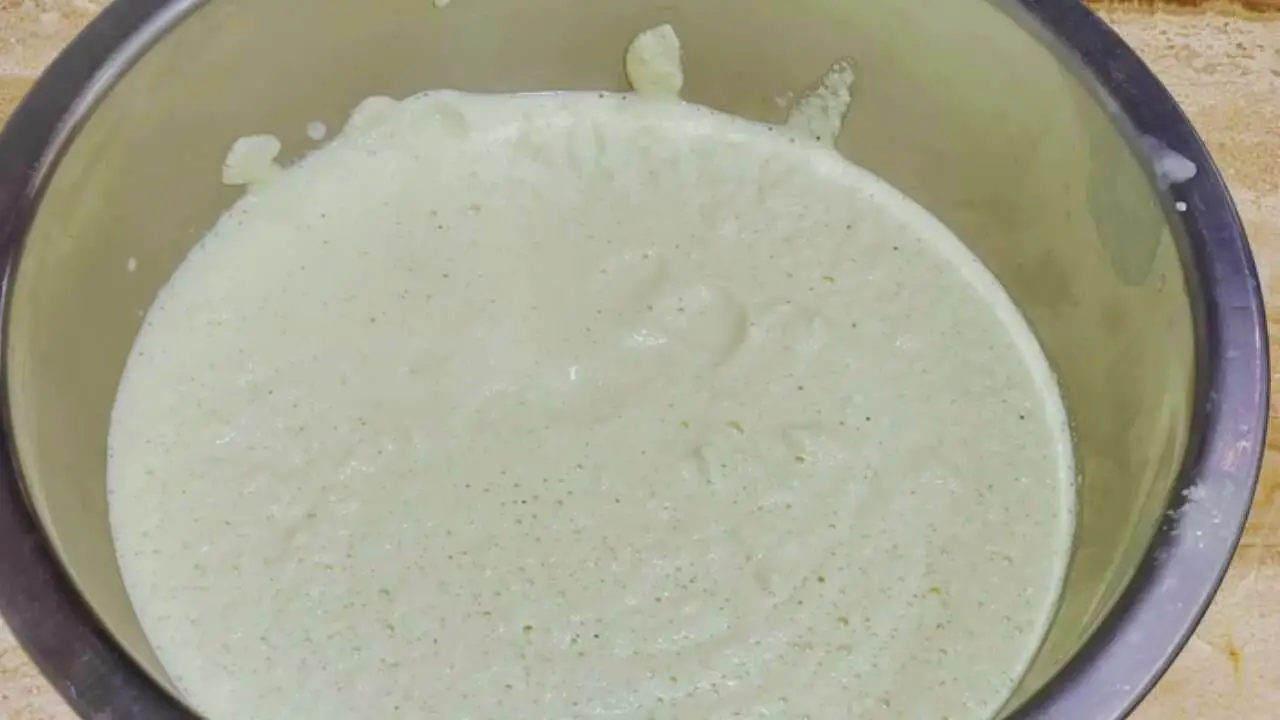
Step 12: Now add ½ tsp of salt to the paste. Mix it nicely.
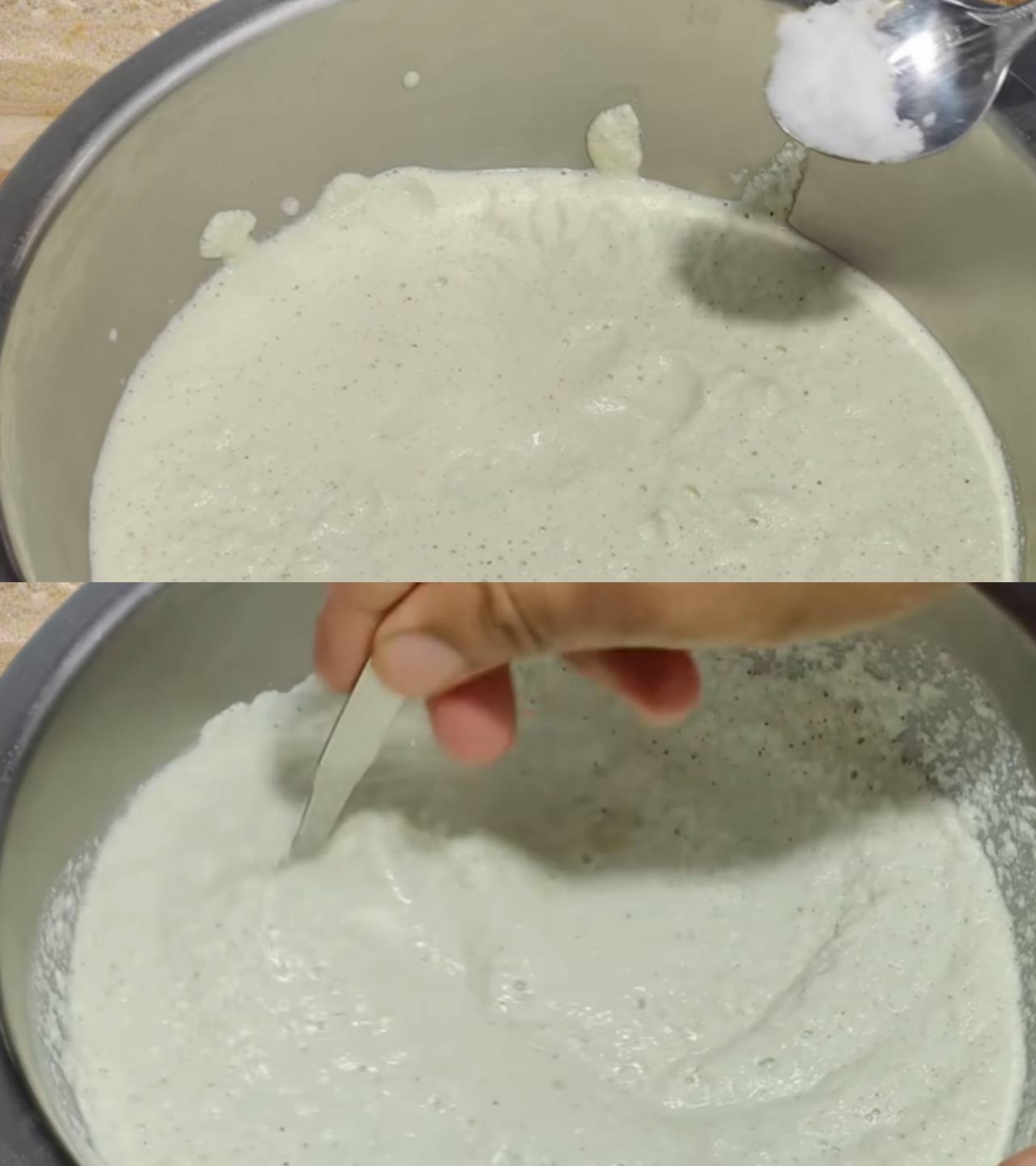
Step 13: Now, to make the tadka for the coconut chutney, take a frying pan and heat 1 tbsp of oil.

(Expert tip: You can use any oil type but using mustard oil is better for added flavor and taste in the chutney).
Step 14: Now add 1 tsp of black gram lentils (urad dal), split and deskinned.
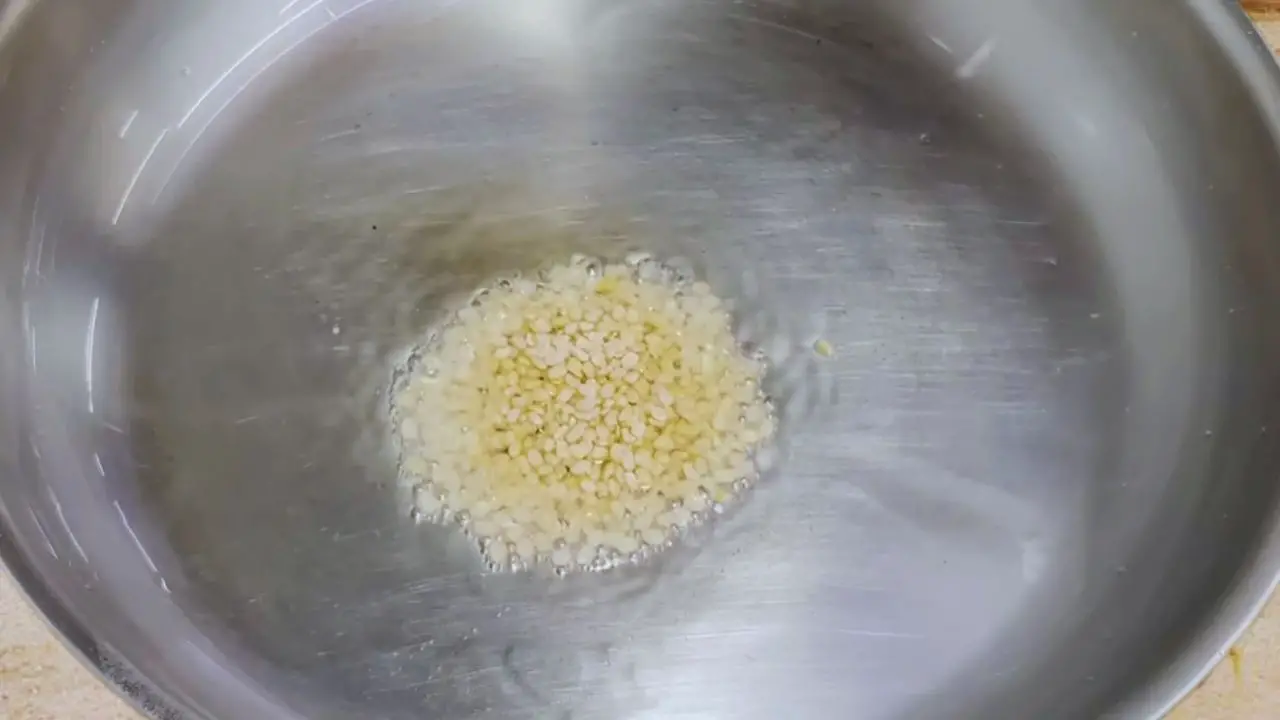
Step 15: Follow it with 1 tsp of mustard seeds.
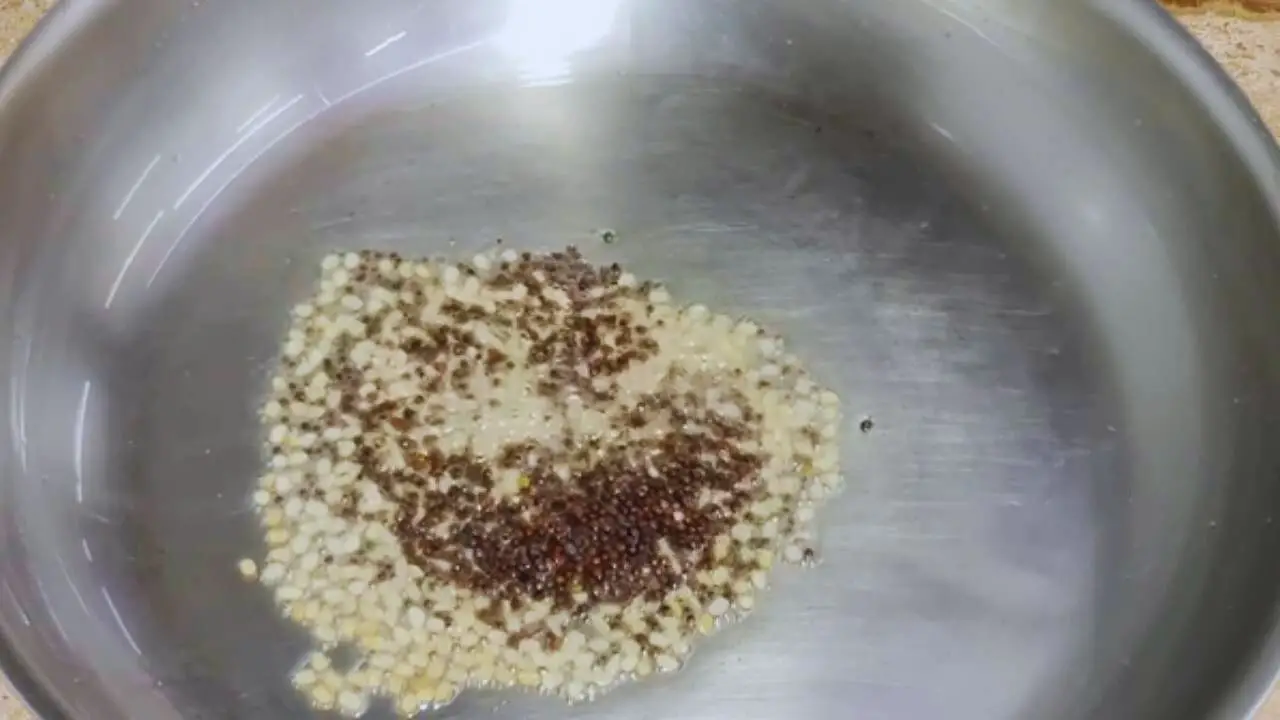
Step 16: Finally add 2 medium-sized pieces of dry red chilies.
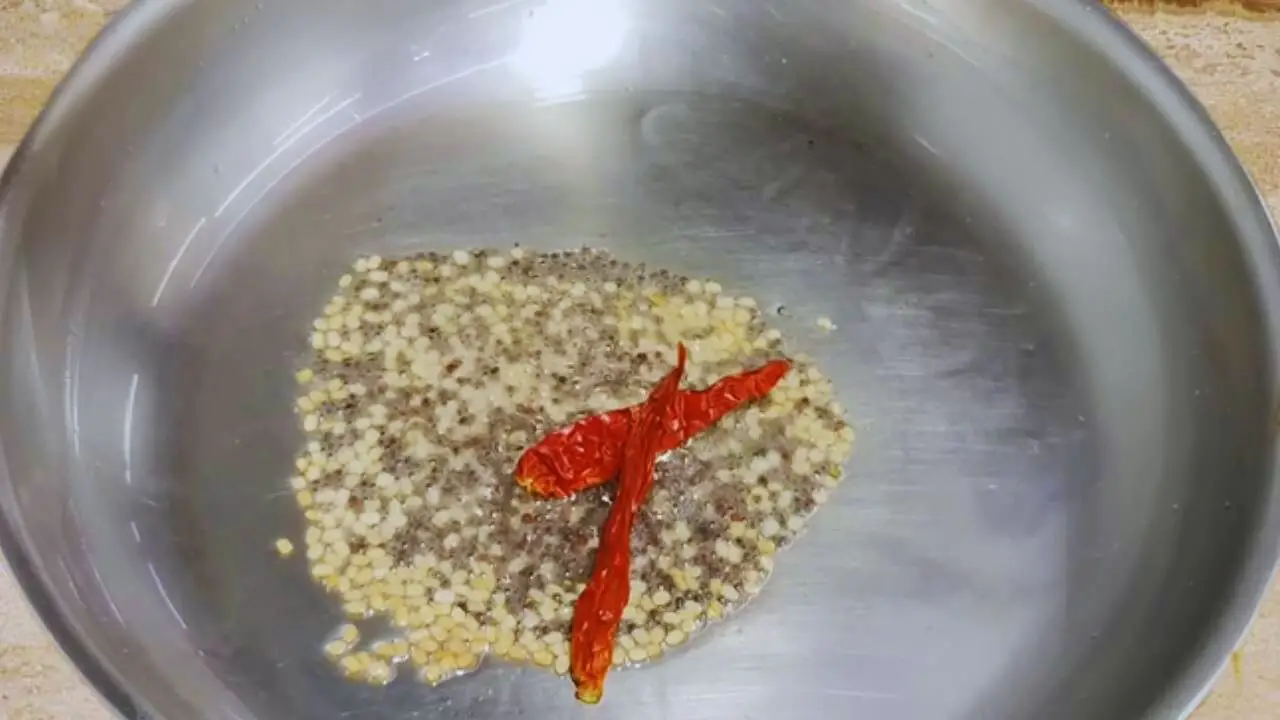
Step 17: Stir the ingredients continuously for some time so that the urad dal is cooked nicely.
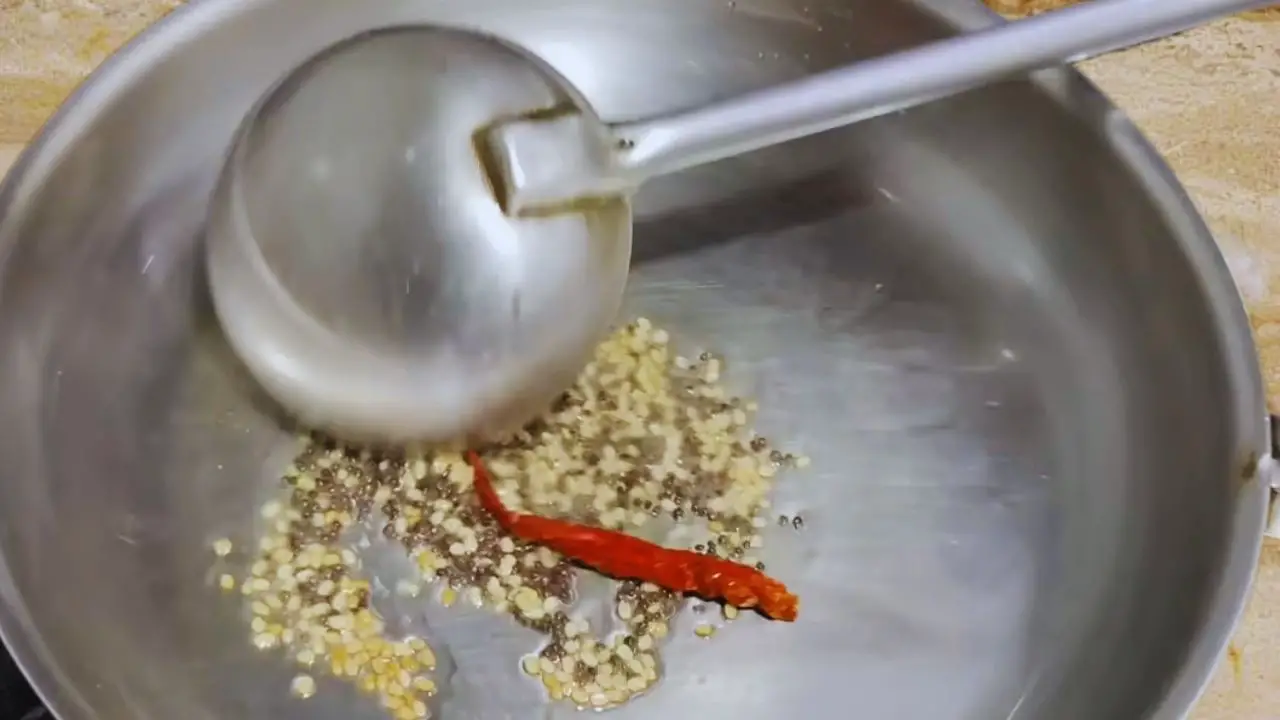
Step 18: Keep an eye on the slight change in the color of the urad dal.
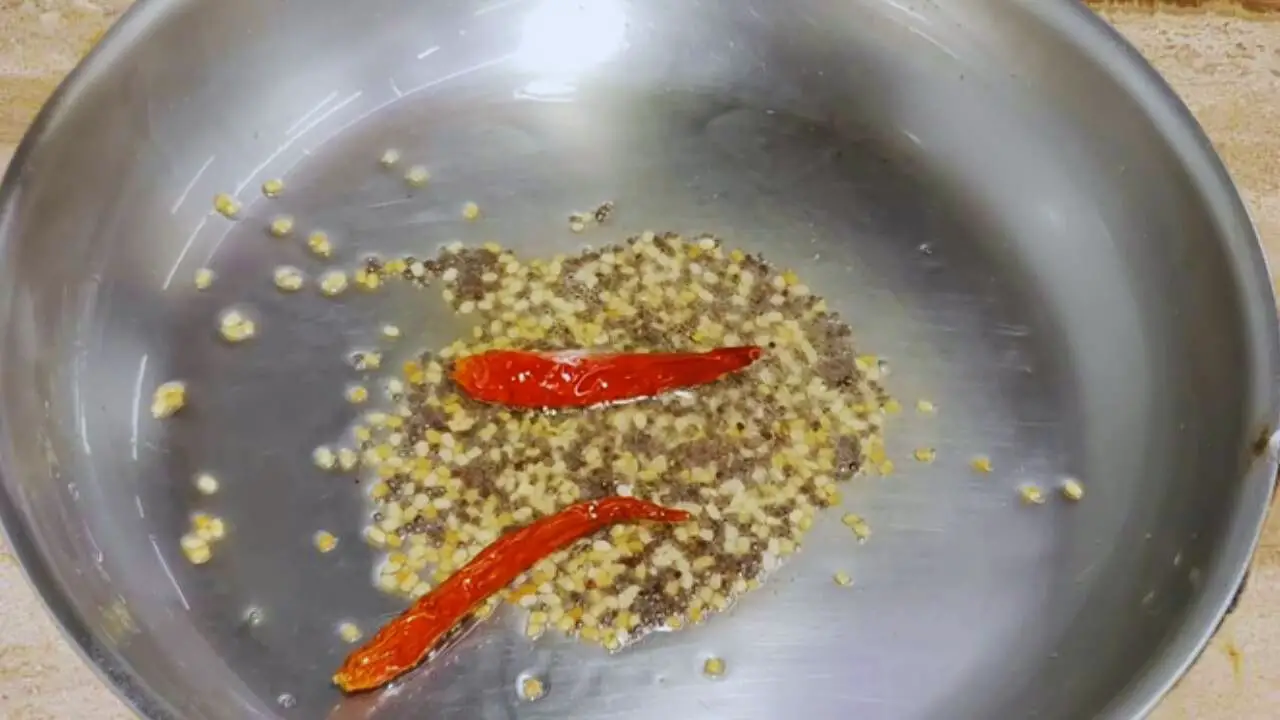
Step 19: Now, add about 10 to 12 fresh curry leaves into the frying pan.
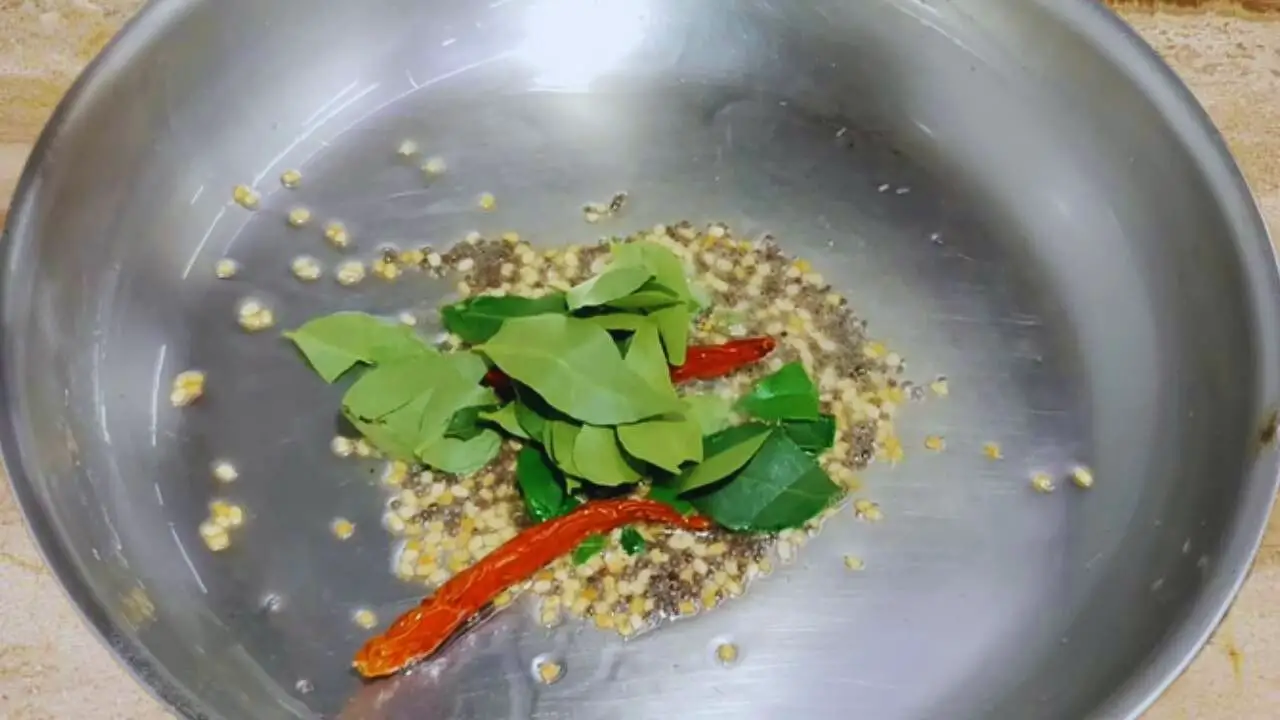
Step 20: Stir for some more time so that the curry leaves are cooked nicely and reduced.
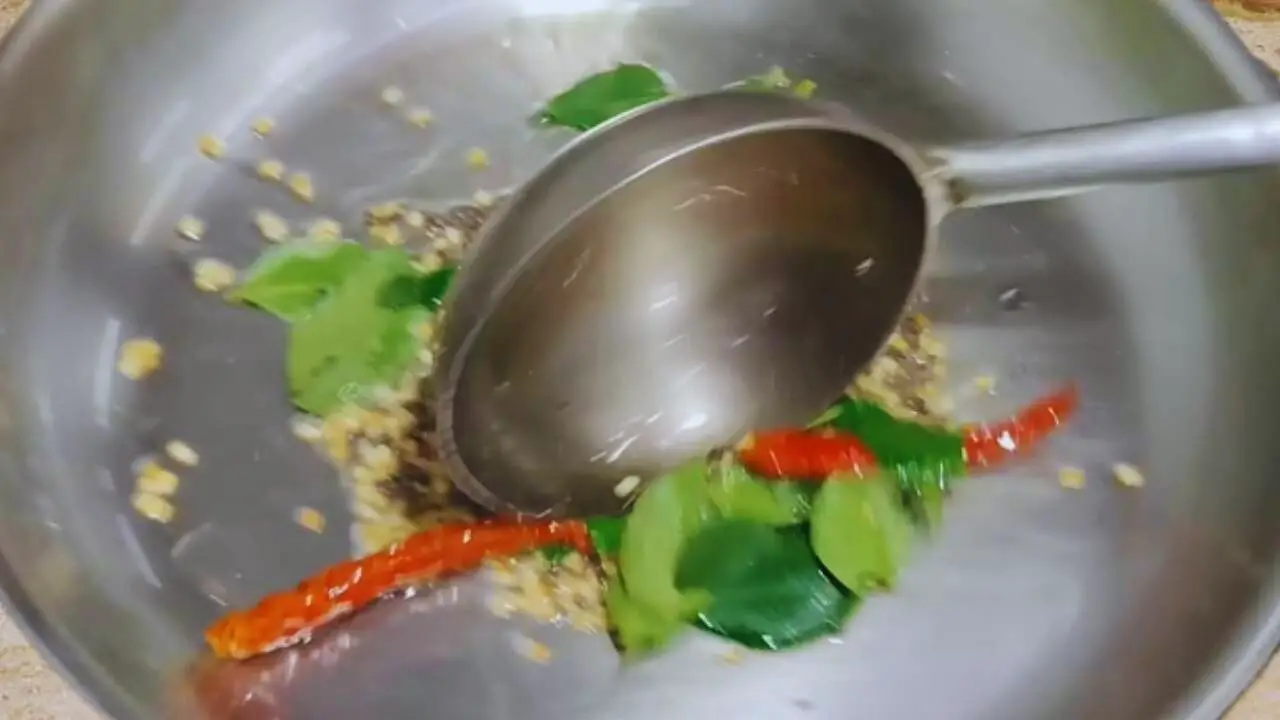
Step 21: Transfer this tadka immediately to the bowl containing the coconut chutney paste.
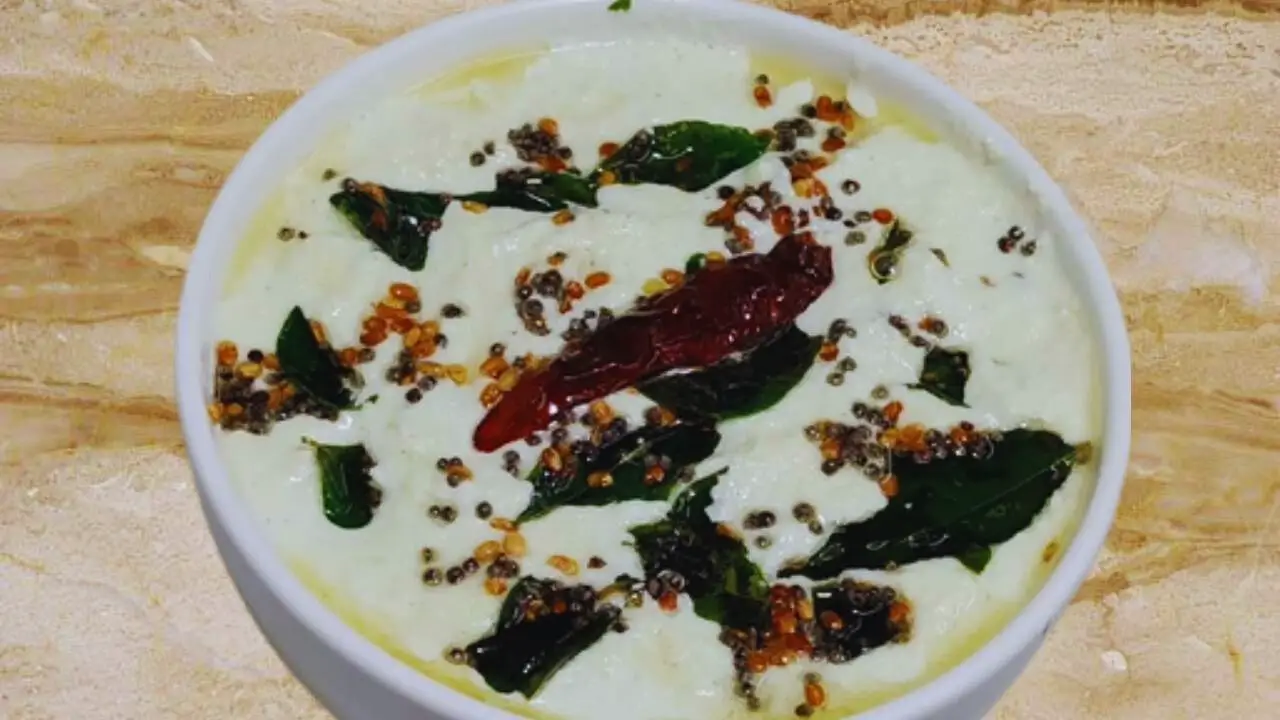
Step 22: Use a spoon to mix them or spread them. One of your dosa coconut chutneys is now ready.
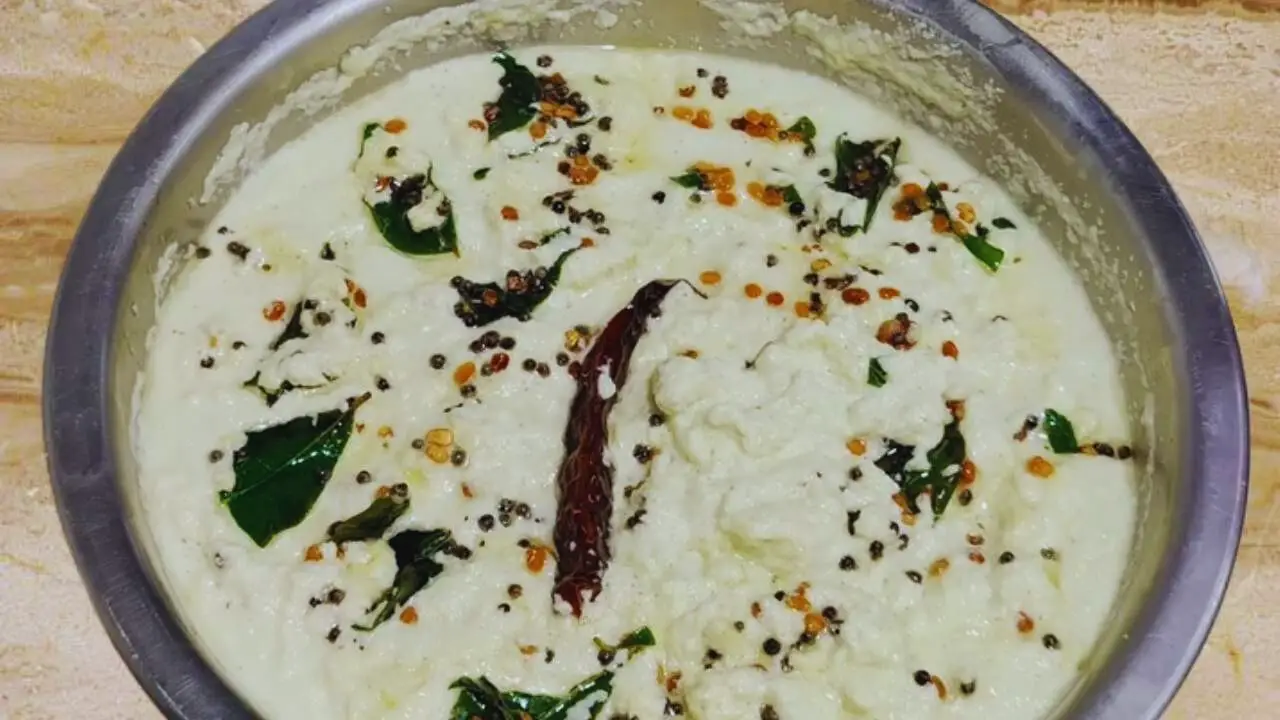
For Dosa Onion Tomato Chutney:
Step 1: Take two medium-sized fresh onions deskin them and slice them roughly. Also, take about 6 fresh and red tomatoes and chop them roughly into small pieces.
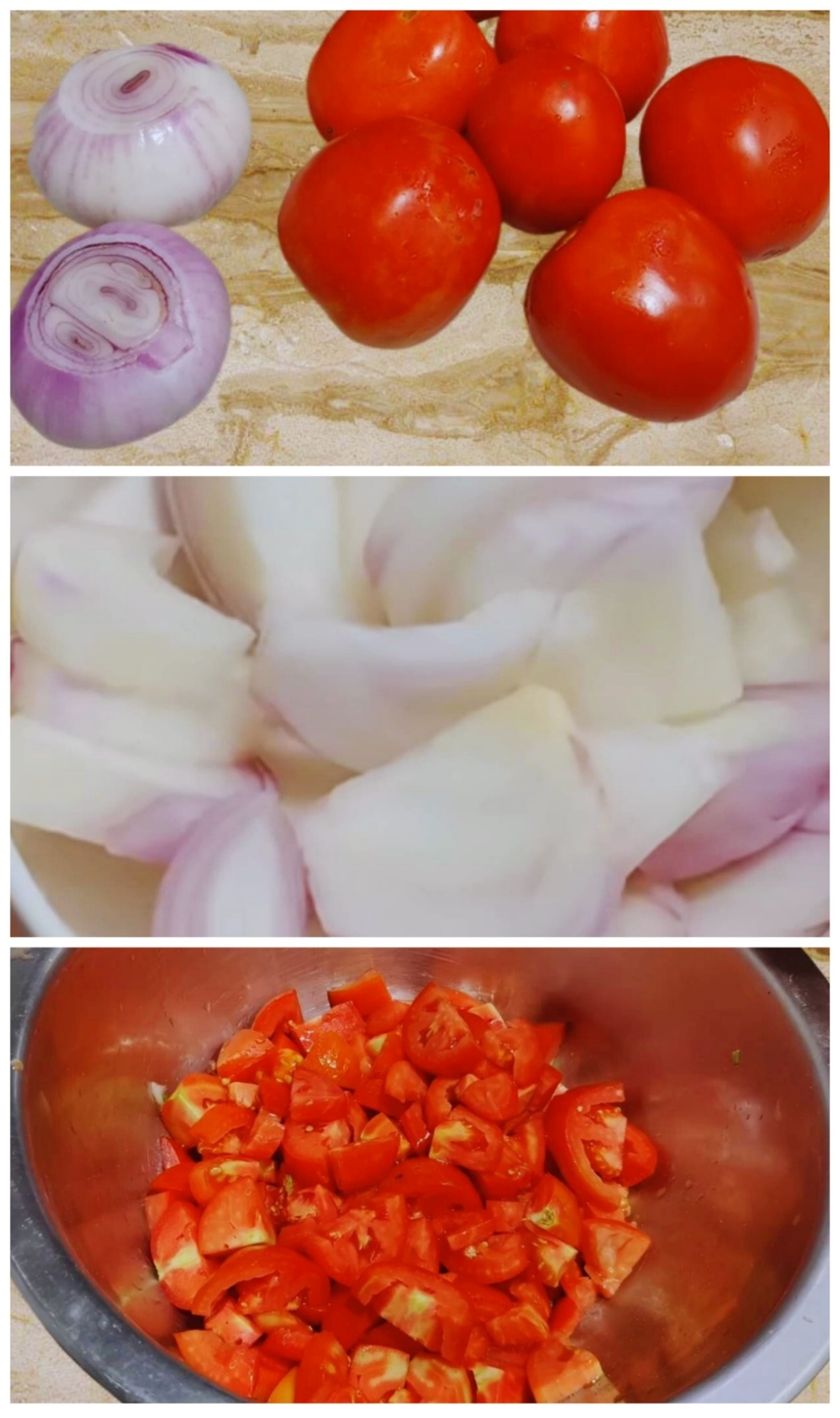
Step 2: Now, when you are done with the cutting, take a wok or a frying pan and heat it on a high flame on your gas stove. When it is hot enough, add 1 tbsp of oil in it. You can use any type of oil you prefer.
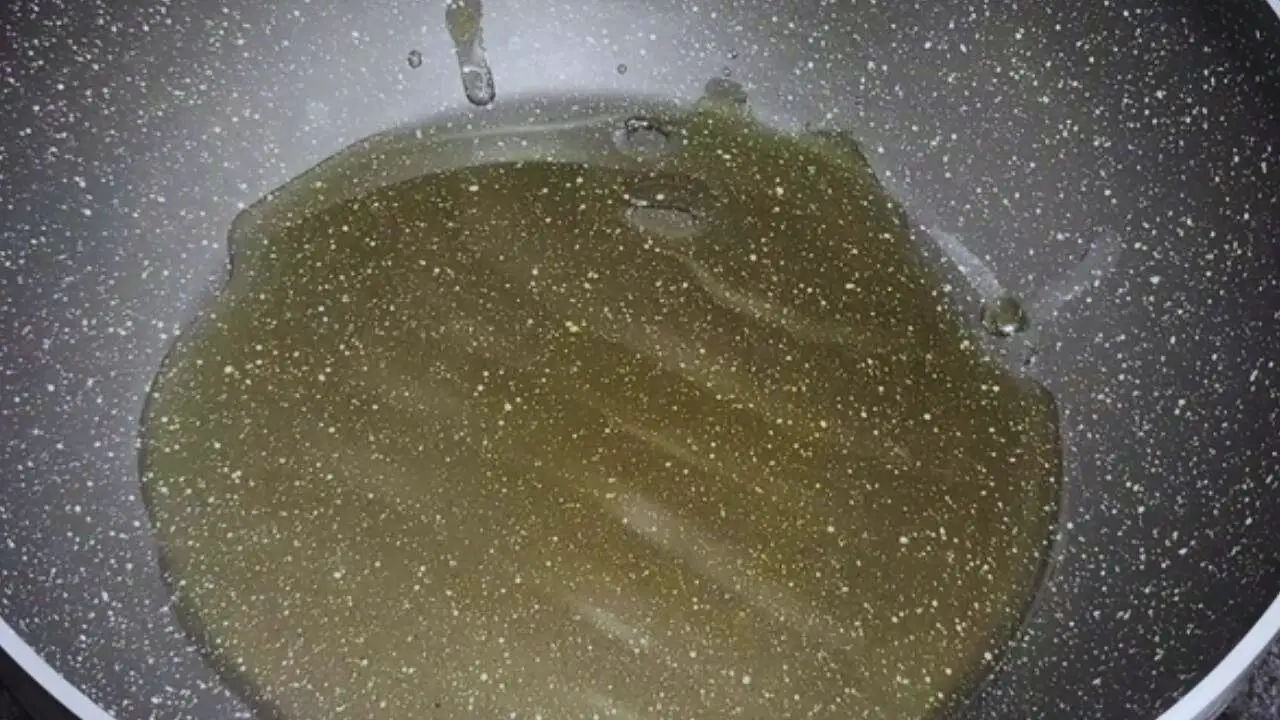
Step 3: Now add 3 pieces of dry Kashmiri red chilies. Tear each of them in half. If you want, you can remove the seeds.
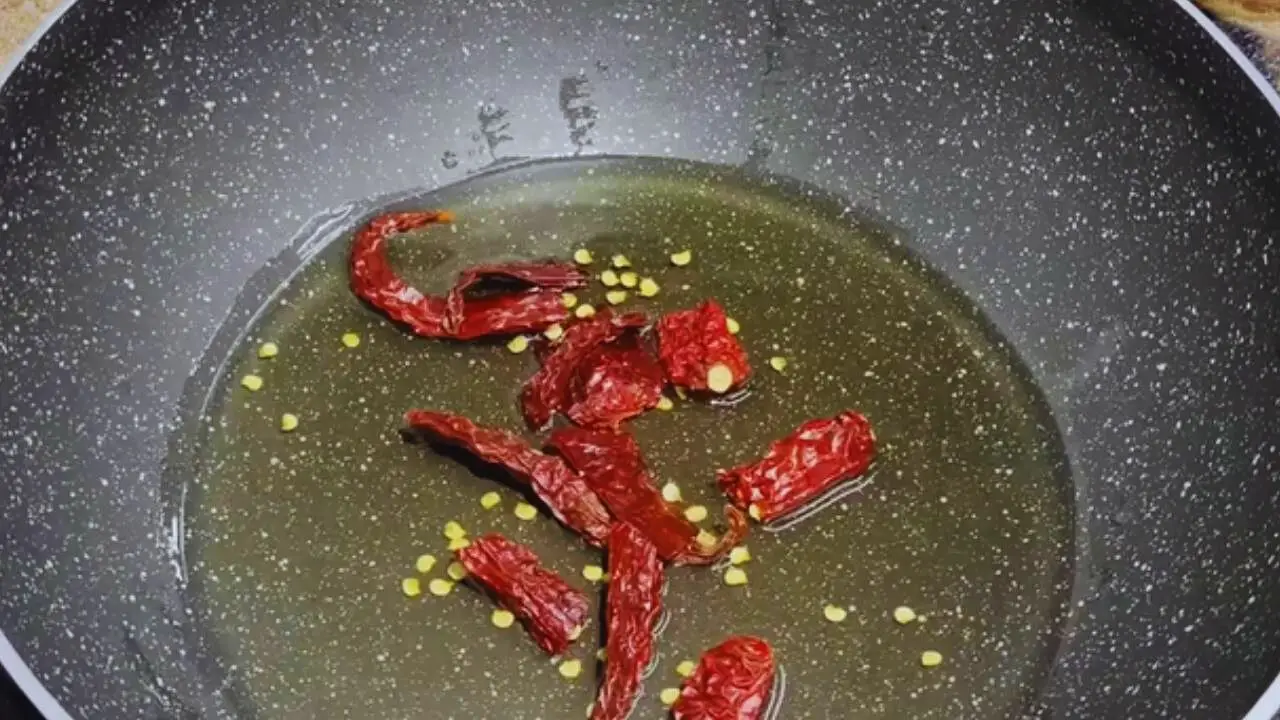
Step 4: Then add 5 fresh cloves of garlic, deskinned and chopped roughly, to the wok.
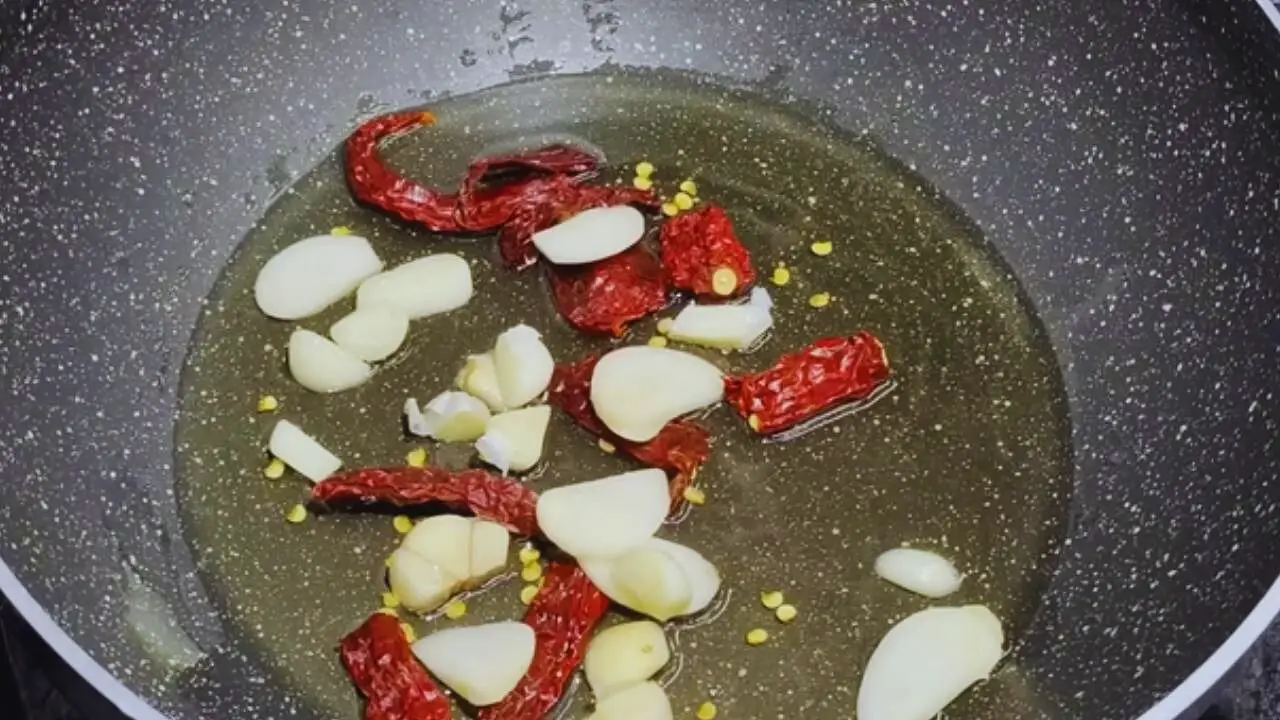
Step 5: Now add a 1-inch piece of fresh ginger to the content, deskinned and chopped roughly.
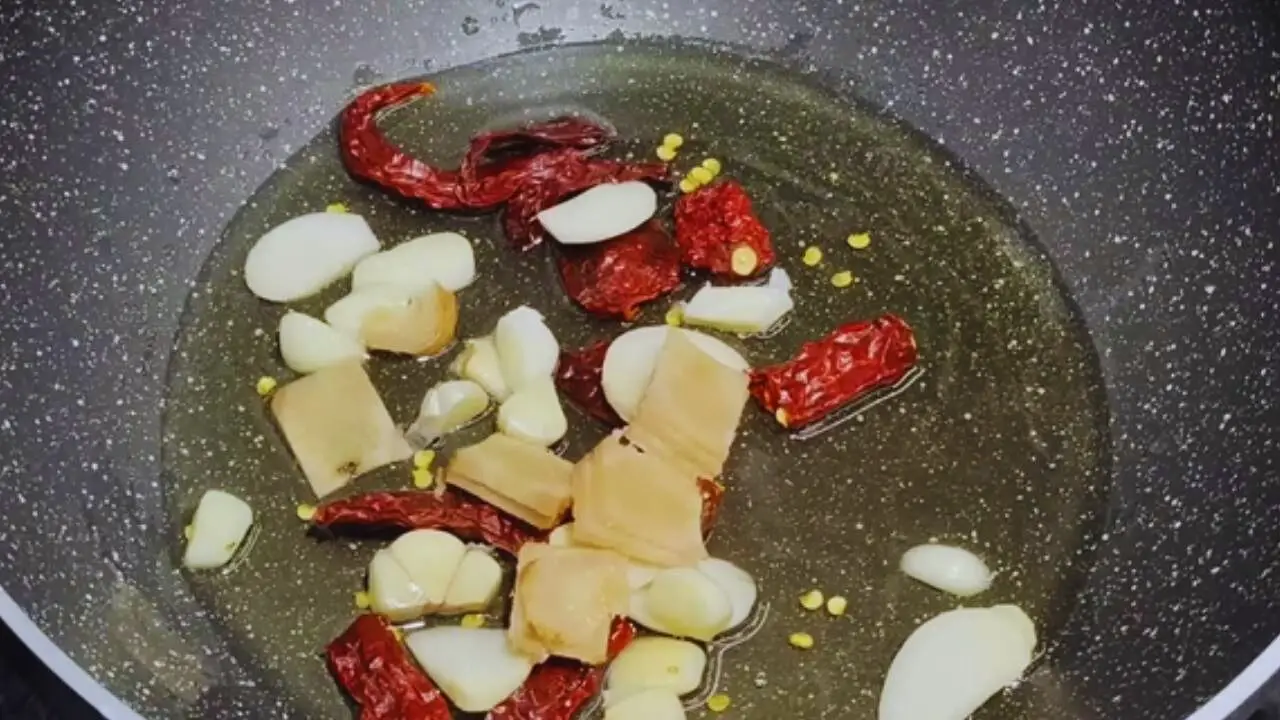
Step 6: Follow it with 1 tsp of mustard seeds.
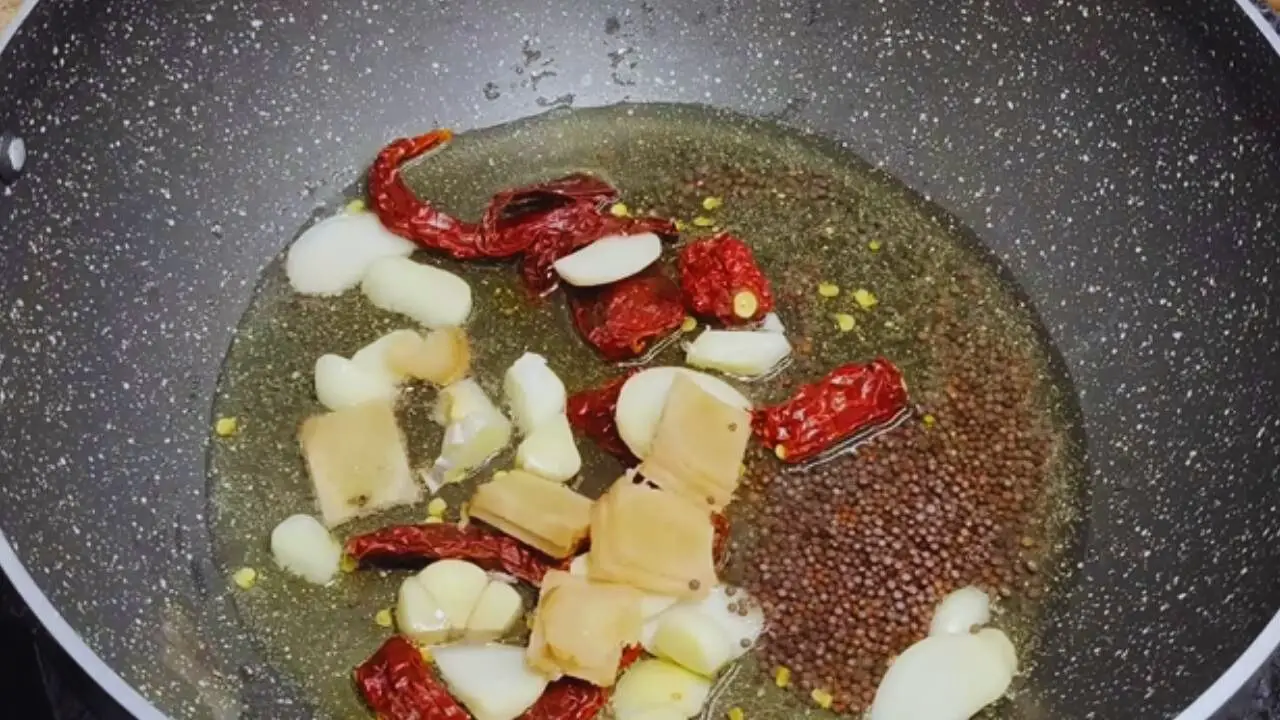
(Expert tip: You may skip adding the mustard seeds at this stage if you want to store the onion-tomato chutney for a couple of days).
Step 7: Also add 10 to 12 pieces of fresh curry leaves to the content.
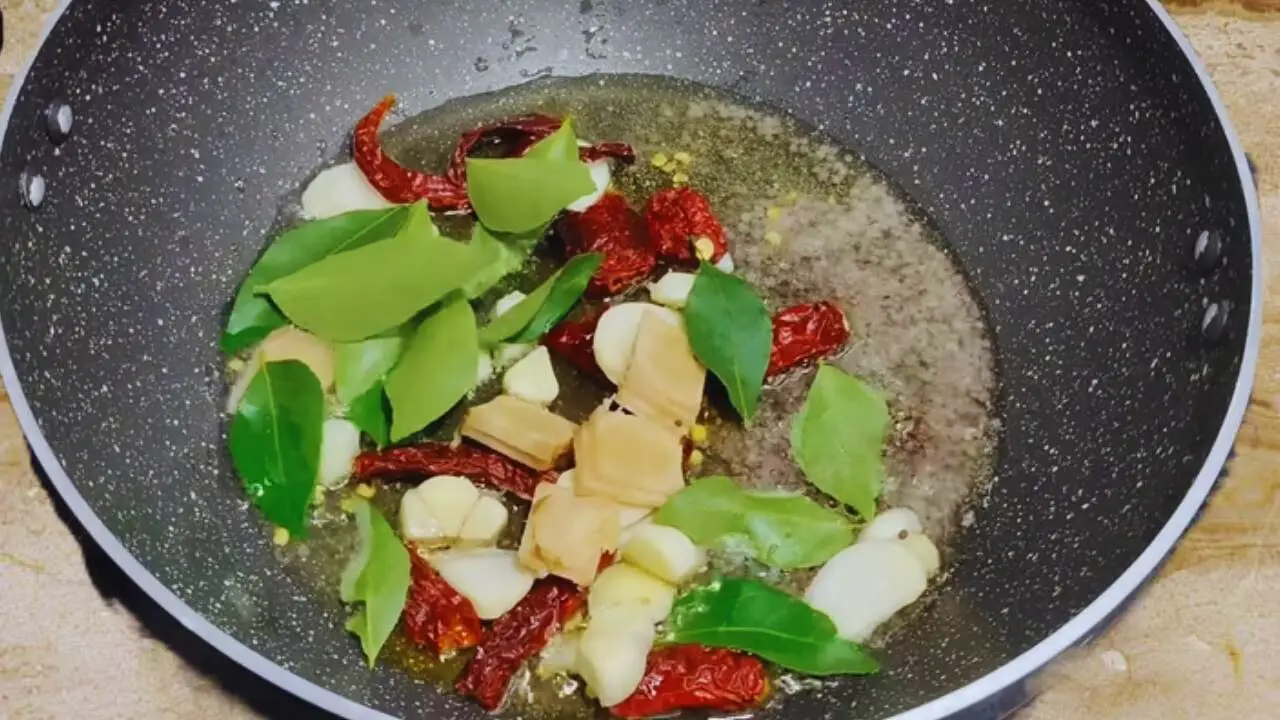
Step 8: Stir the ingredients to cook the ginger and garlic a bit.

Step 9: Now add 1 cup of the sliced onion to the ingredient in the wok.
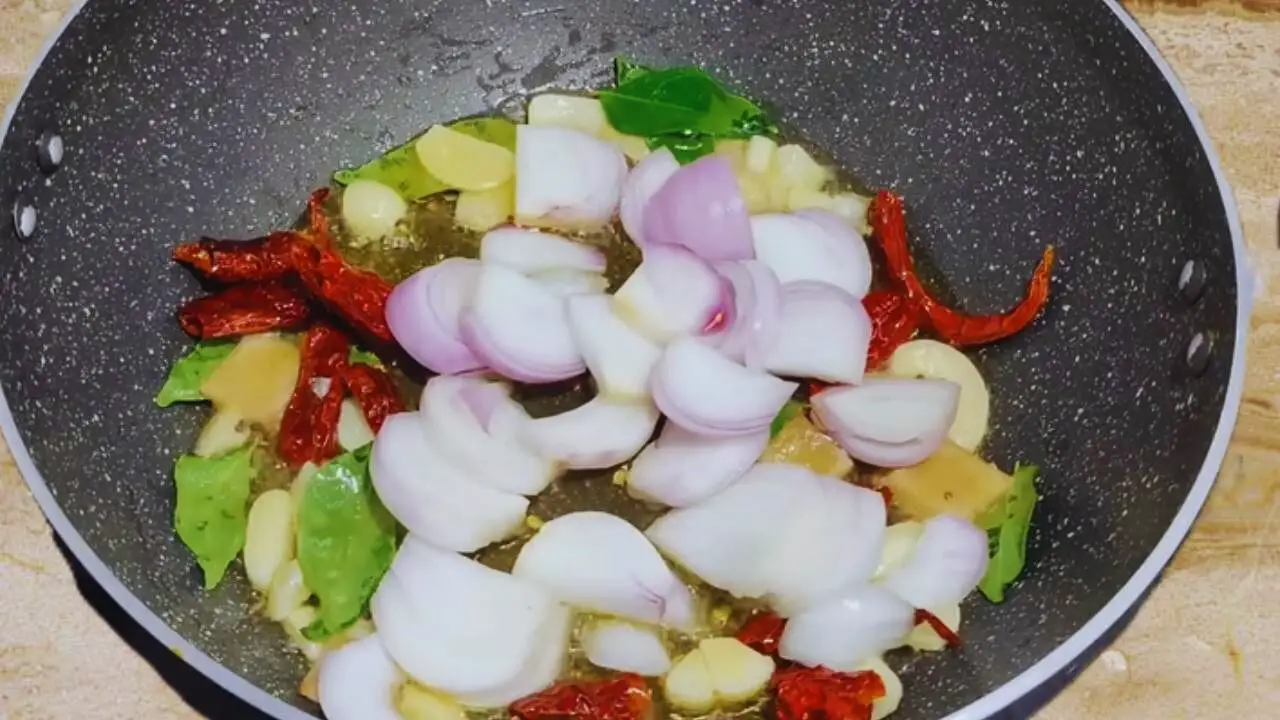
Step 10: Stir and cook the onion on a medium flame for about 2 to 3 minutes until they turn translucent.
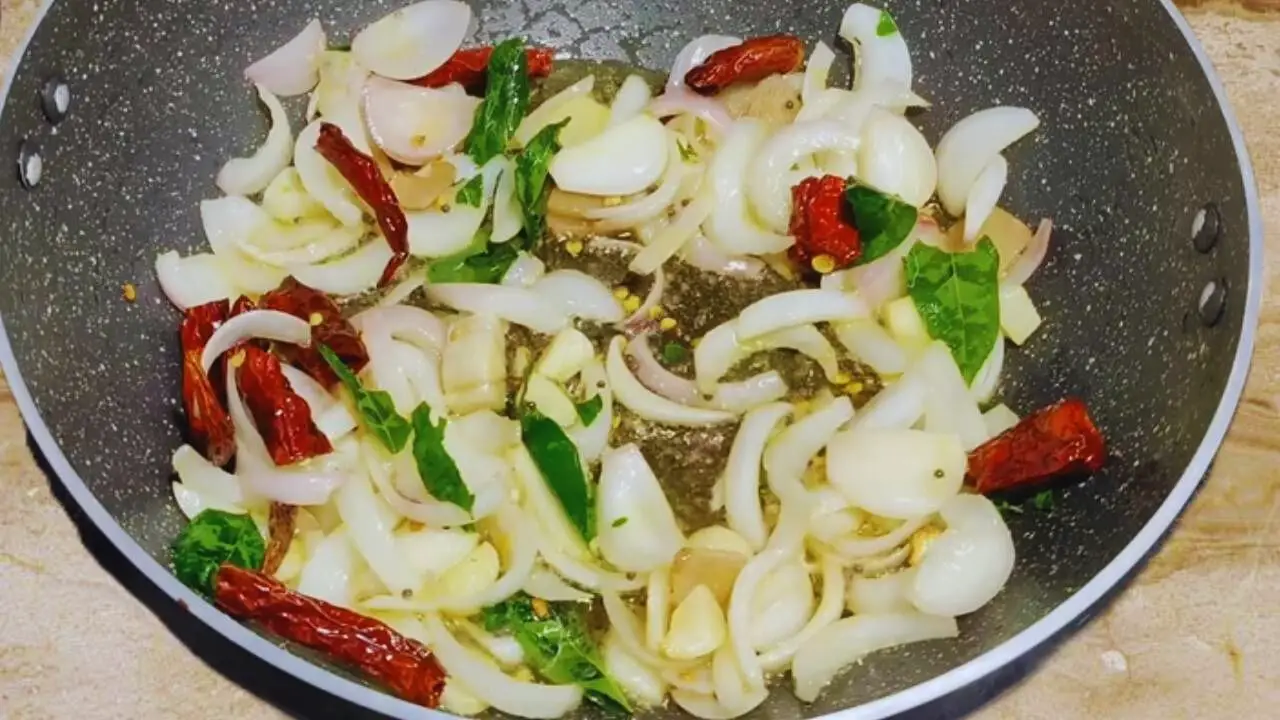
(Expert tip: It is crucial to cook the onion nicely. It will remove the raw taste and smell of the onion).
Step 11: At this stage, add 2 cups of the roughly cut tomatoes to the content in the wok.

Step 12: Also add ½ tsp of table salt to it.
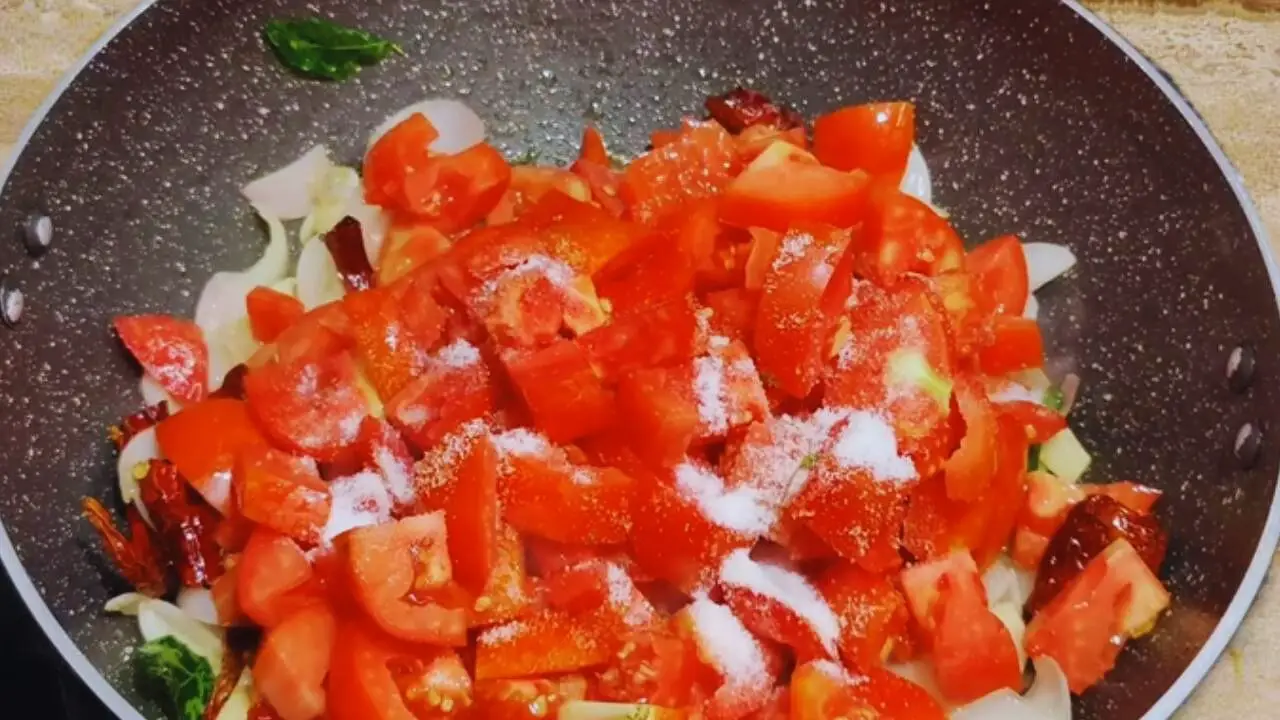
Step 13: Then add 1 tsp of Kashmiri red chili powder to it.
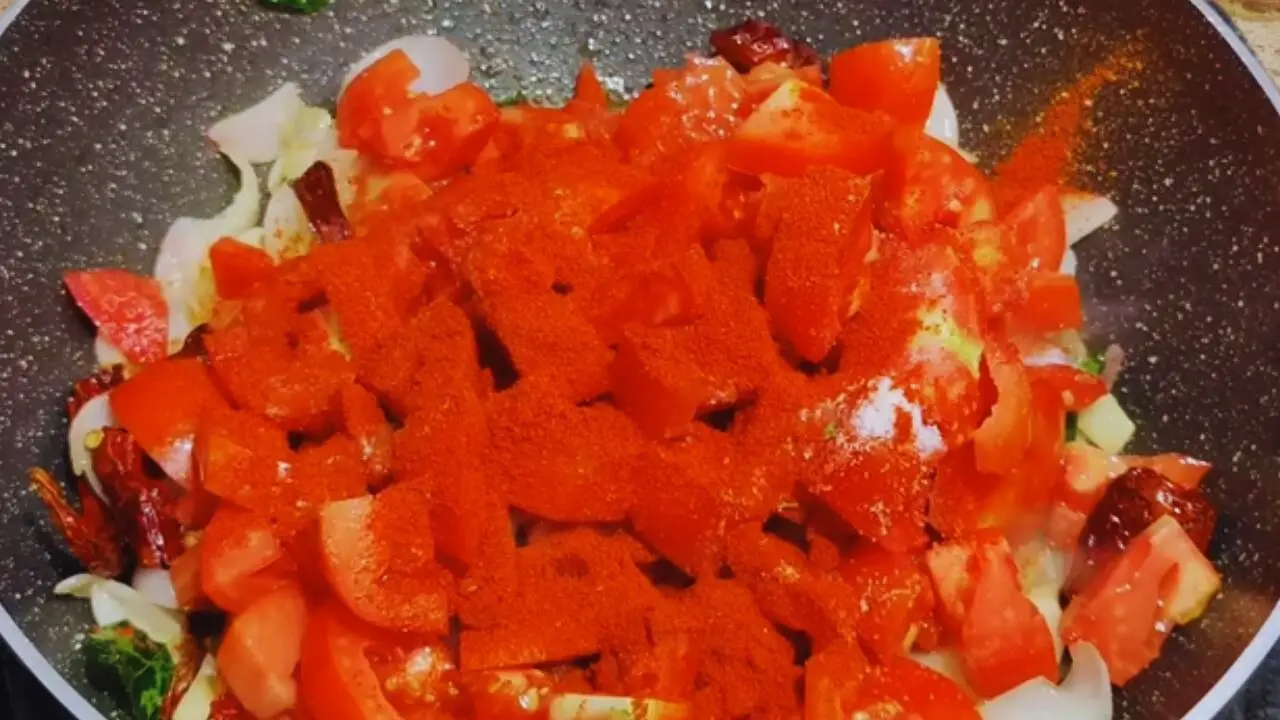
Step 14: Now stir and mix everything nicely for about 3 to 4 minutes. Now, cover them to cook for about 10 to 12 minutes more on a high flame.
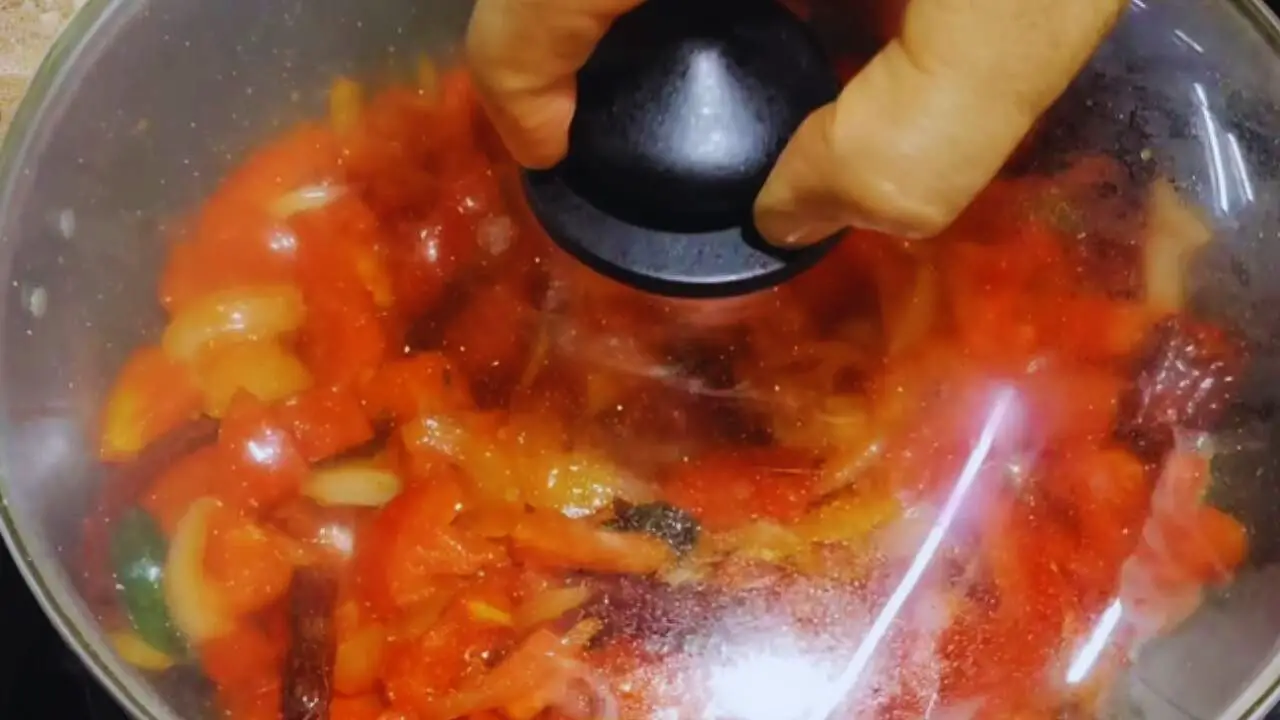
Step 15: While it does, take a frying pan, heat it, and add about ½ tbsp of oil to it.
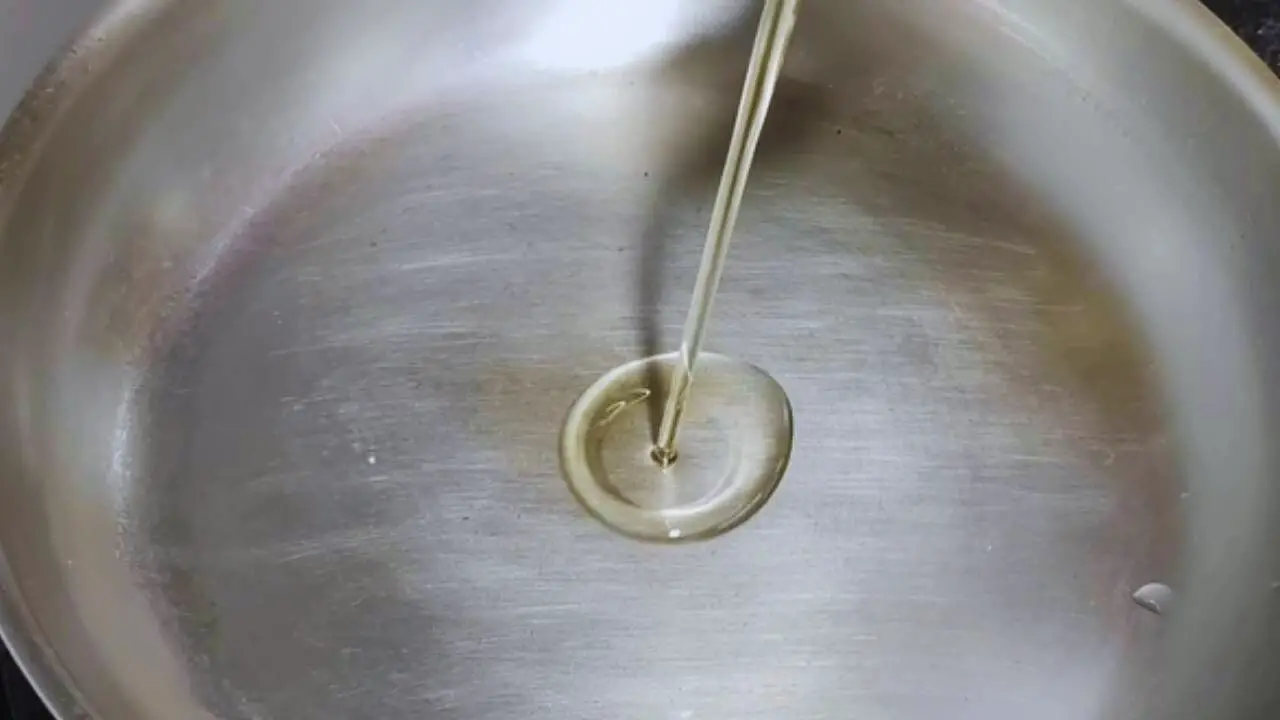
Step 16: Now put 2 tbsp of roasted split chickpeas (chana dal) dal into the pan.
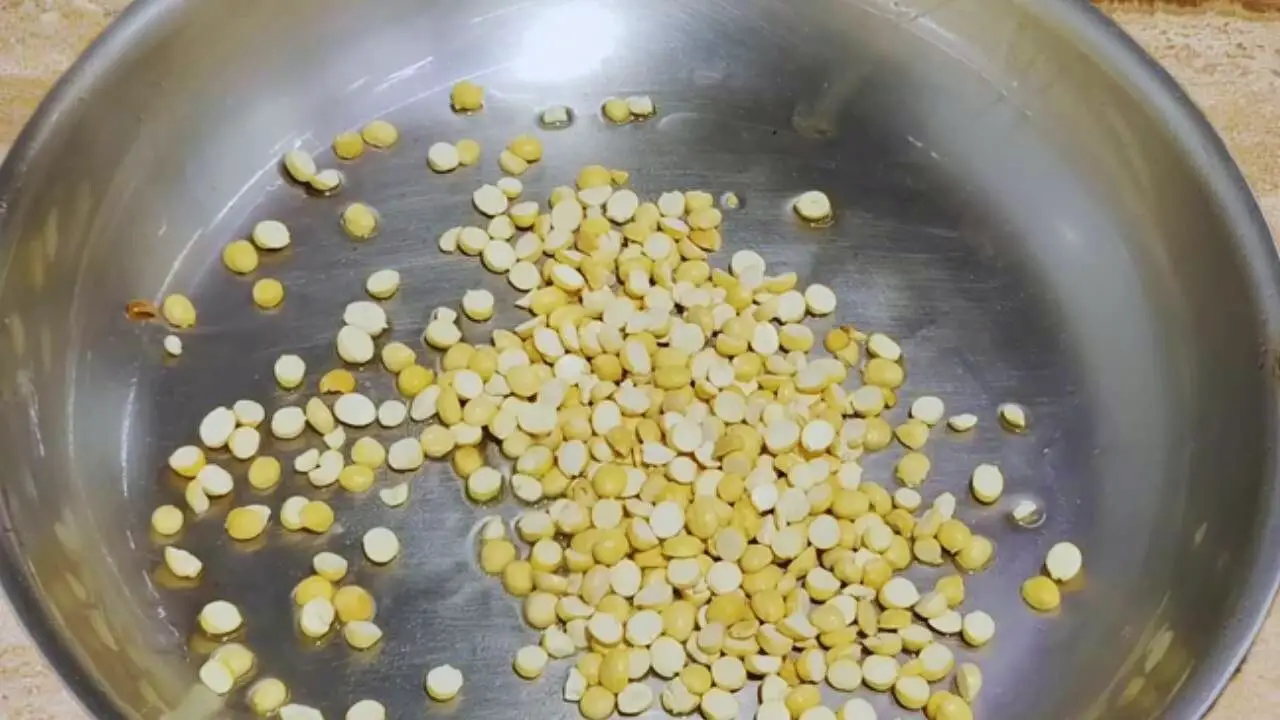
(Expert tip: If you do not have roasted chana dal, you can use roasted peanuts as an alternative to it).
Step 17: Stir them to cook on a medium flame until you notice a slight change in the color of the roasted split chickpeas.
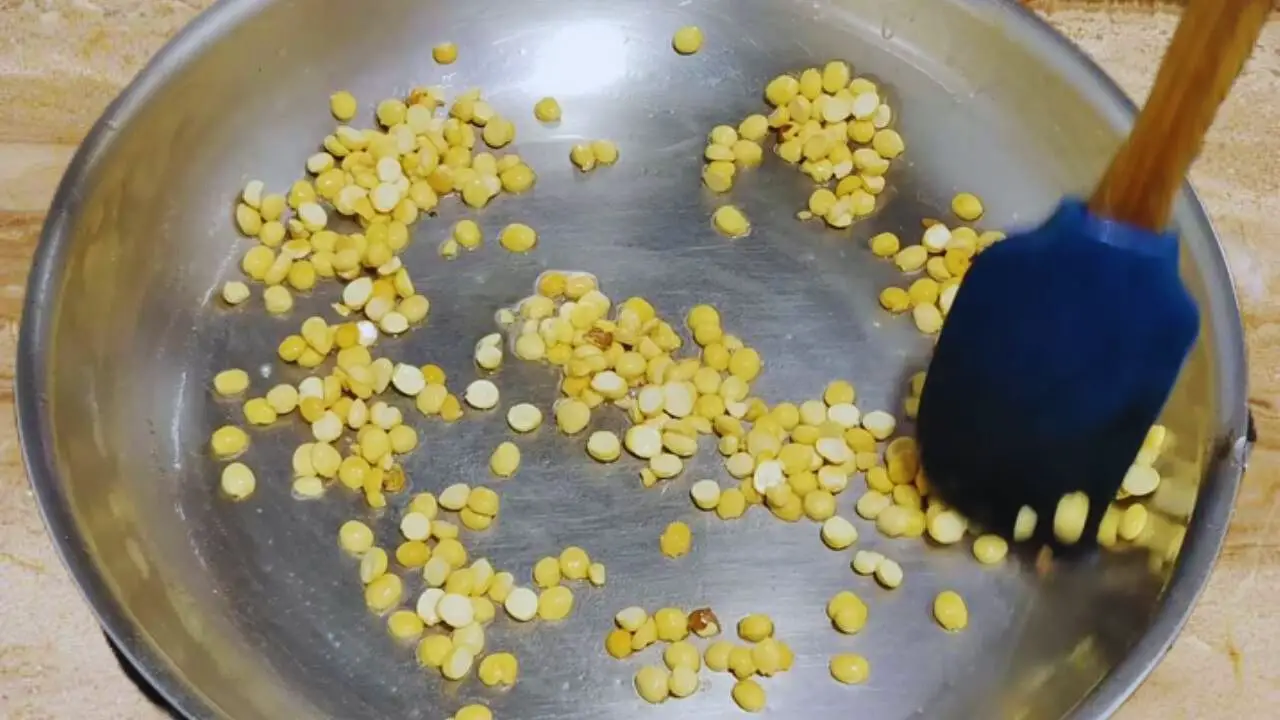
Step 18: Now, remove the cover from the wok to see how the onion-tomato is cooked. You will notice the color of the content has changed significantly and has cooked nicely to become soft and succulent. Add the roasted chana dal to it.
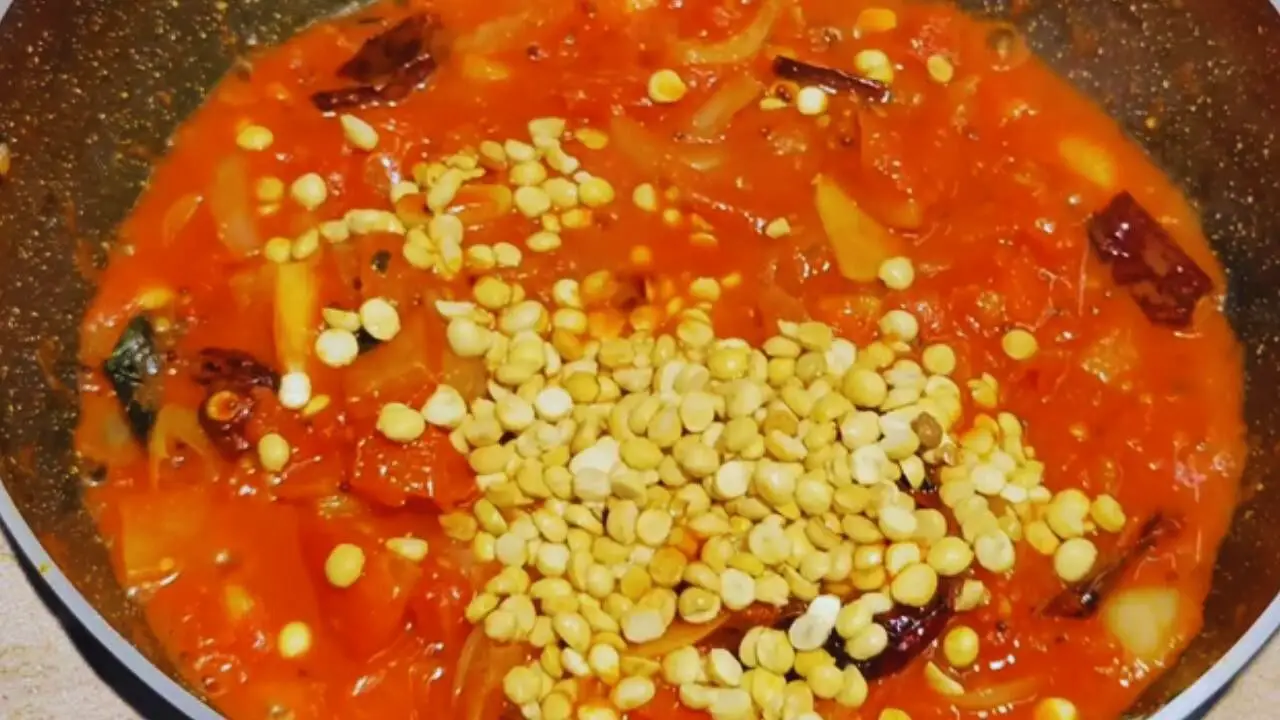
(Expert tip: You may also add the roasted split chickpeas (chana dal) when you add ginger and garlic. This will ensure better cooking of the dal).
Step 19: Mix everything and cook them for about 5 minutes more.
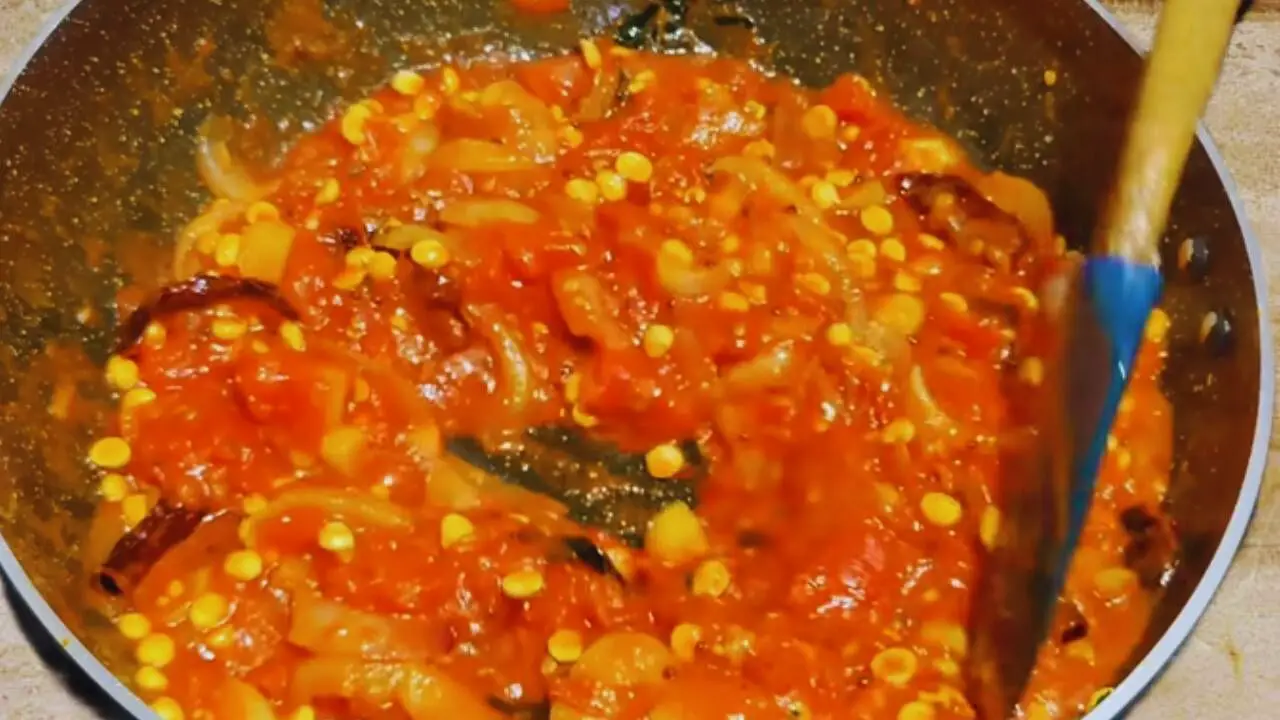
Step 20: When it is done, turn off the flame of your gas stove and let the ingredients cool for some time.
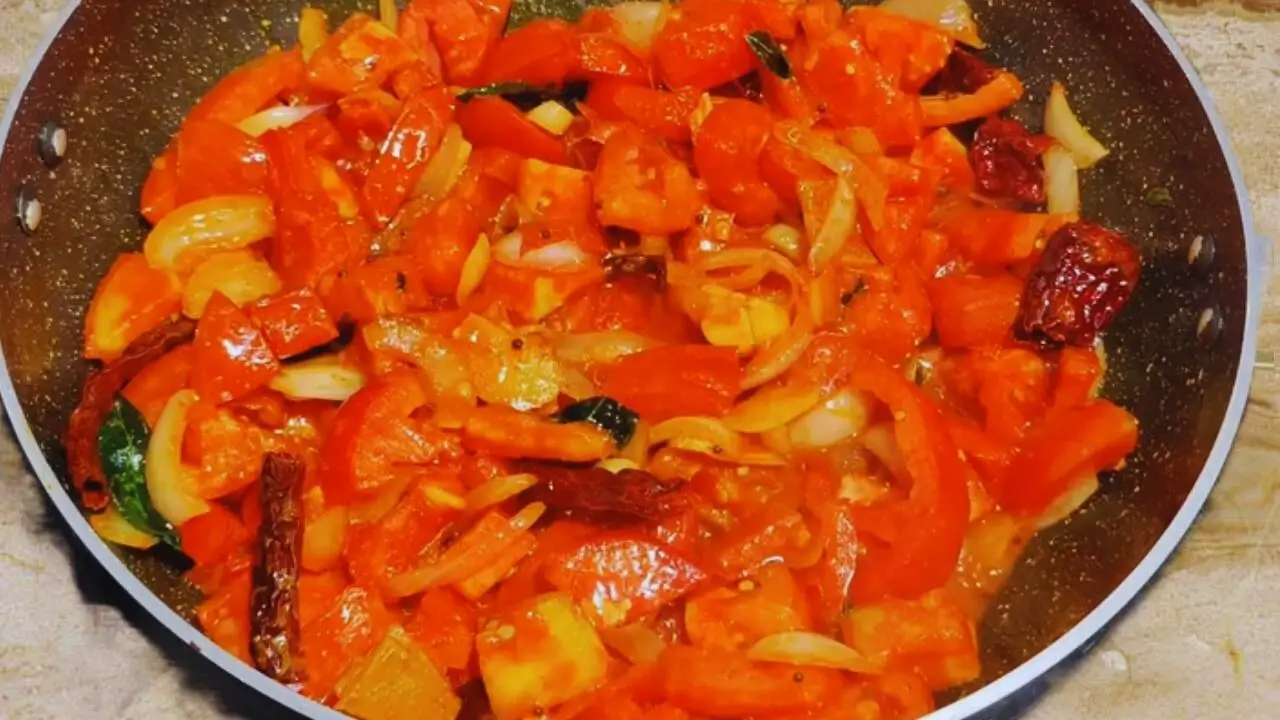
Step 21: Take a grinder.
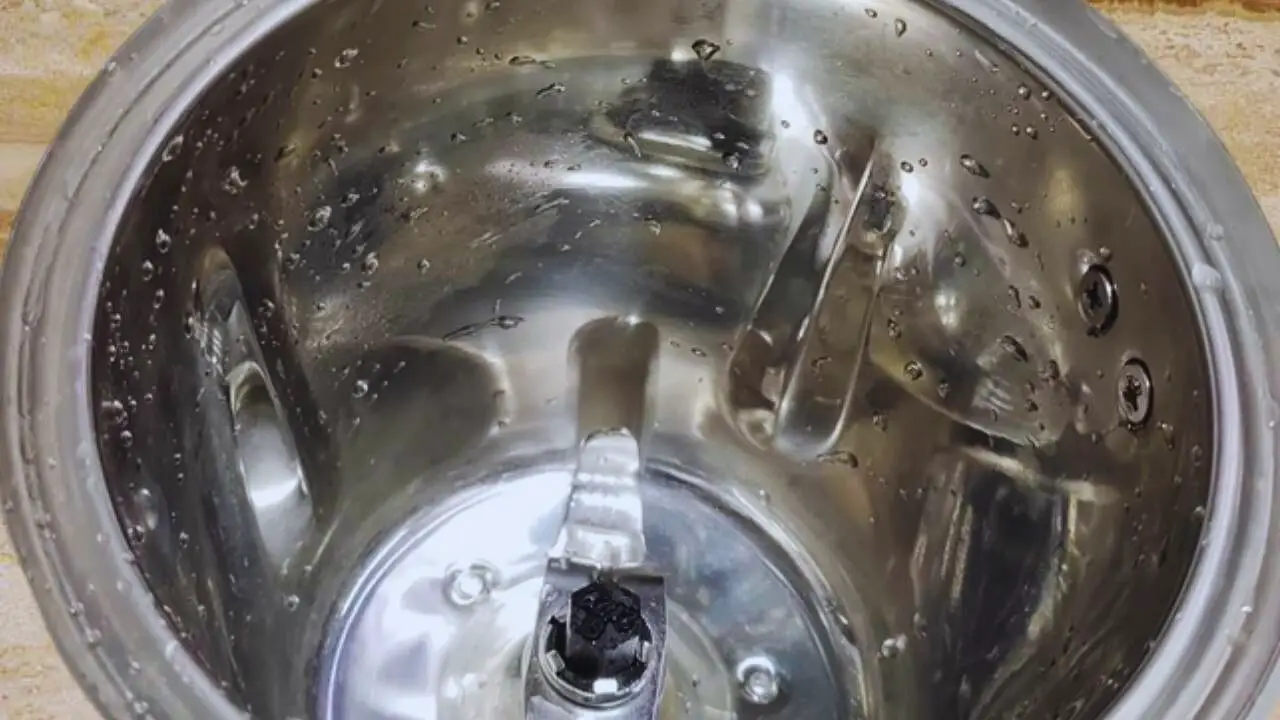
(Expert tip: Take a different grinder or wash the one you used before to make the coconut chutney for the distinct flavor of onion-tomato chutney).
Step 22: Transfer the content to it.
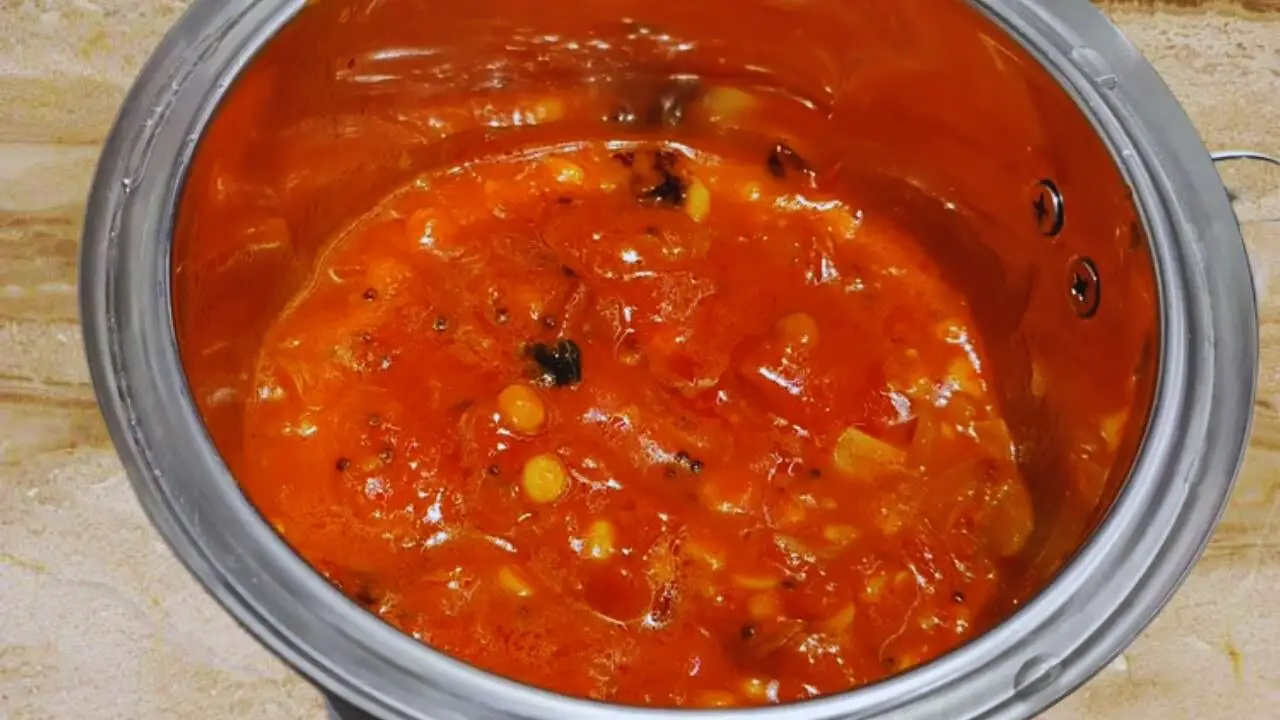
Step 23: Blend them nicely to get a fine and smooth paste. Transfer it into a bowl as well.
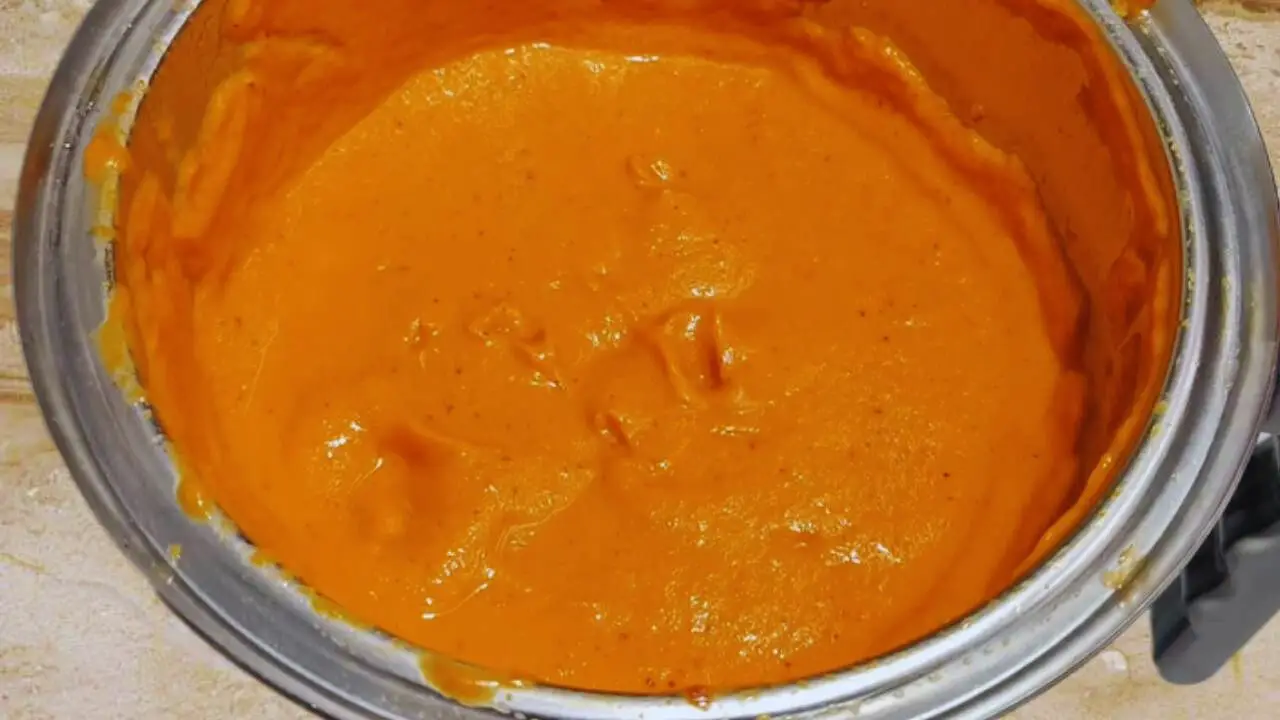
(Expert tip: Do not add any more water to it. If you do so, your chutney will be spoilt very soon).
Step 24: For the tadka, take a frying pan, heat it on a high flame, and add 1 tbsp of oil to it.
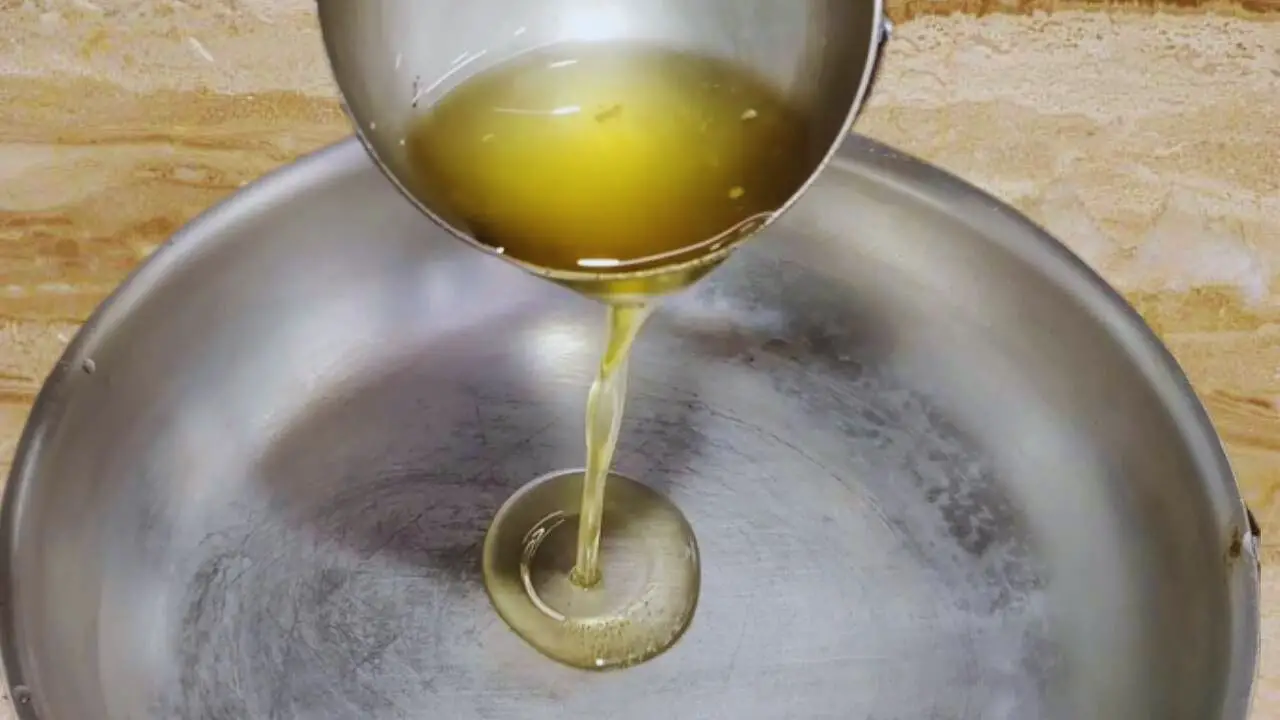
Step 25: When the oil is hot enough, add 1 tsp of split and deskinned black gram lentils (urad dal) and 1 tsp of roasted split chickpeas (chana dal) to it.
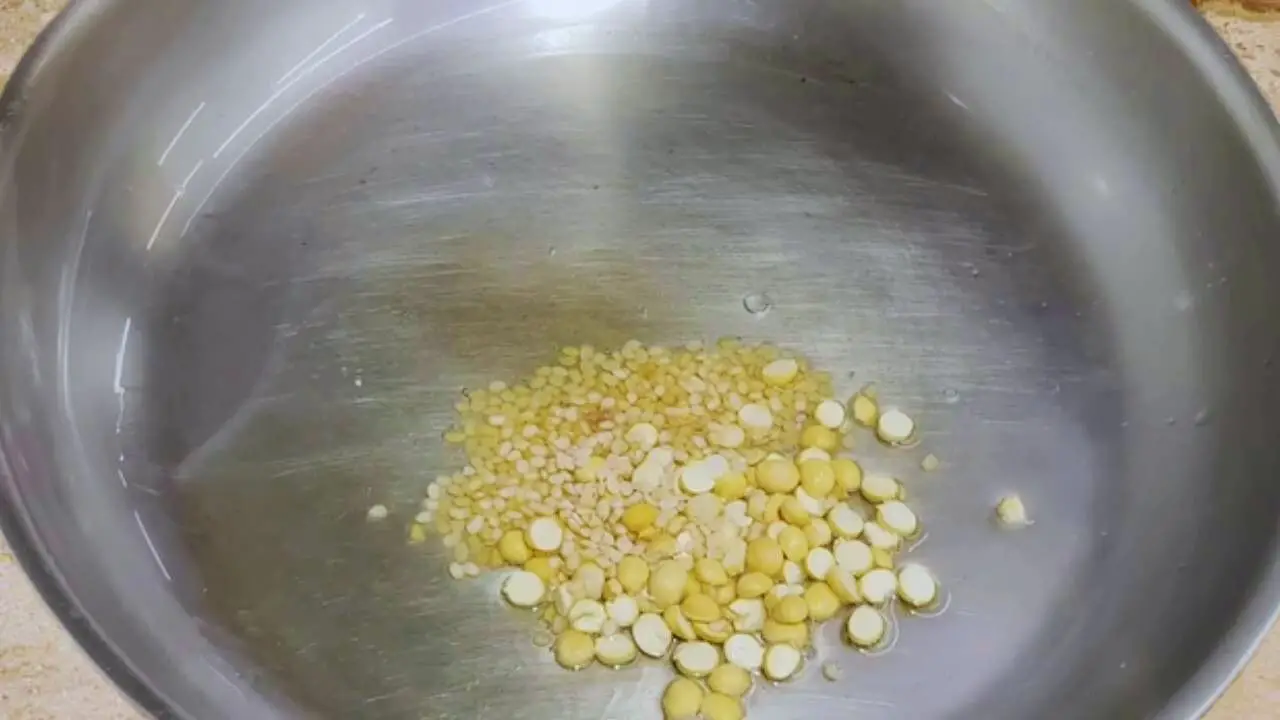
Step 26: Then add ½ tsp of mustard seeds to it and let them crackle.
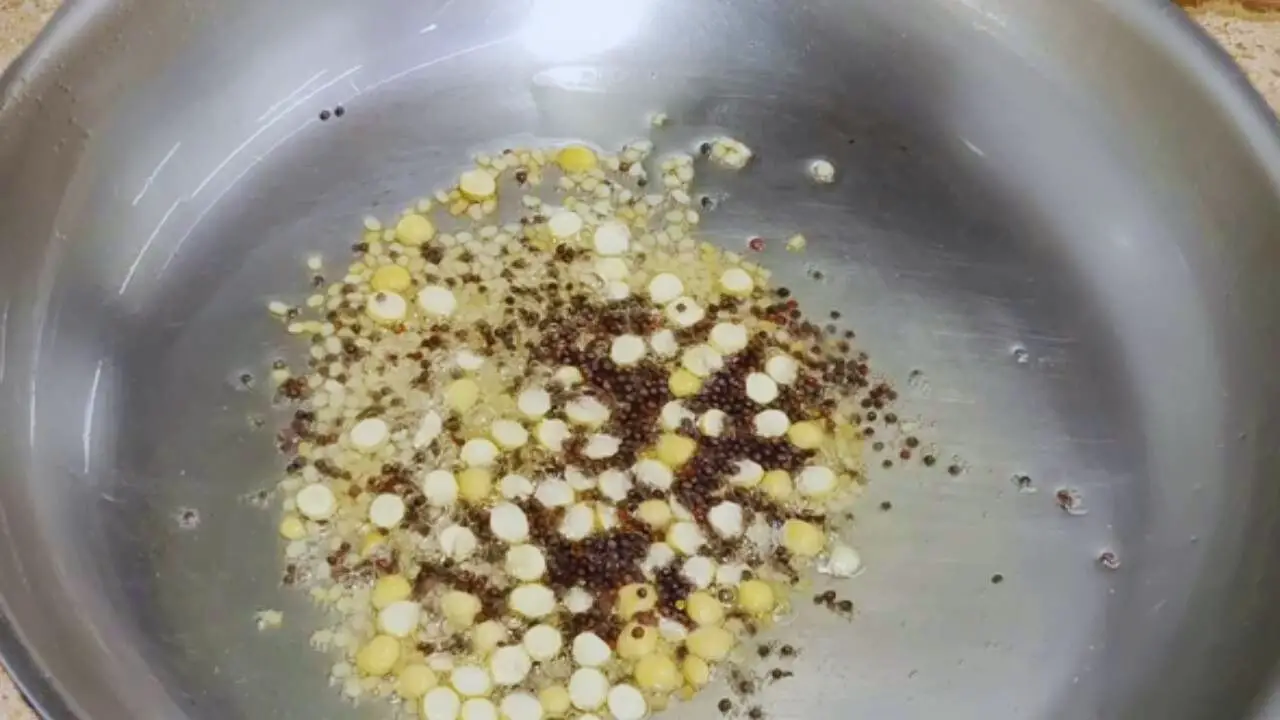
(Expert tip: Be careful. When the mustard seeds crackle, they may sprinkle hot oil all over).
Step 27: When the mustard seeds stop crackling add 3 medium-sized pieces of dry red chilies to the ingredients in the frying pan.
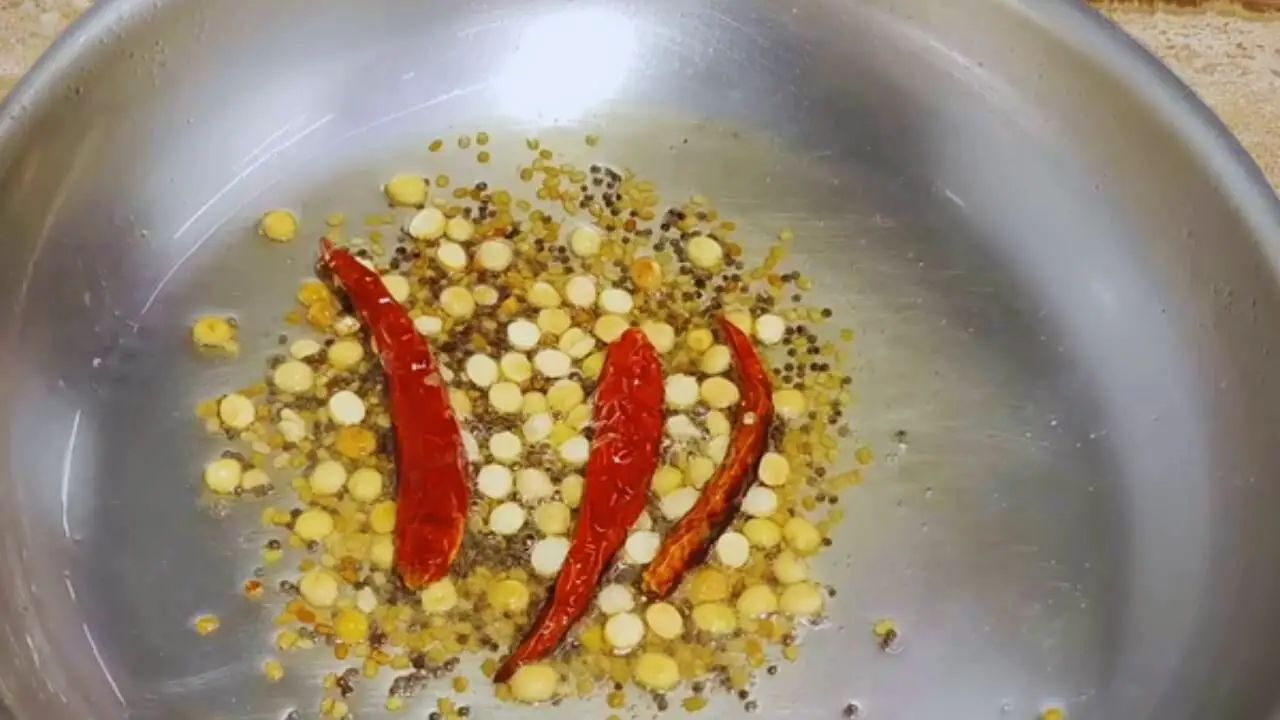
Step 28: When everything is cooked nicely add 6 pieces of finely chopped fresh curry leaves.
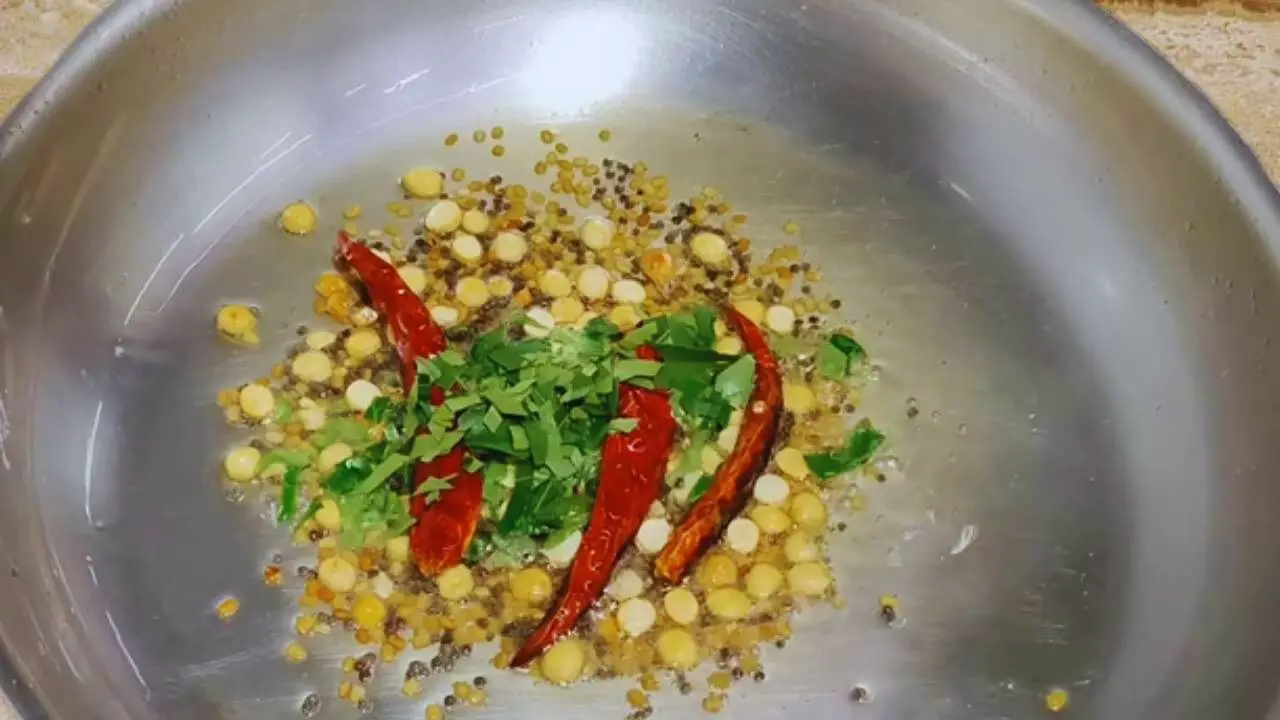
Step 29: Cook them for about half a minute and pour the tadka immediately on the paste.
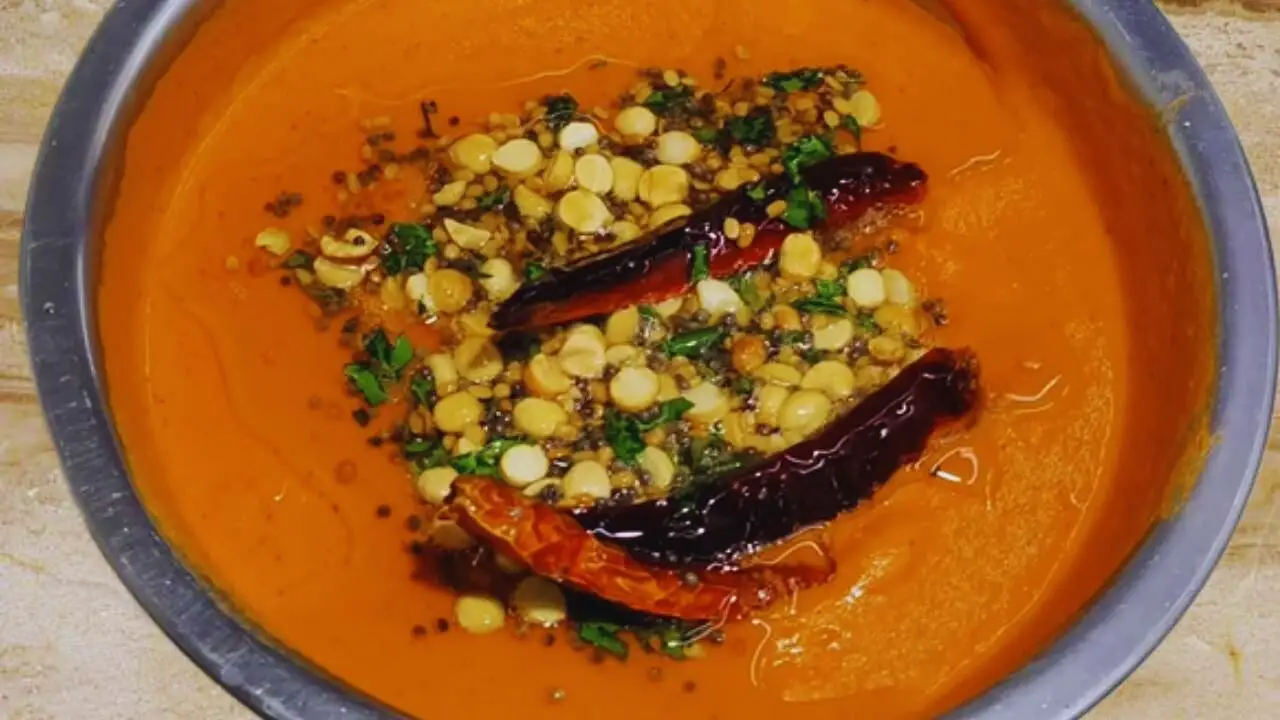
Step 30: Mix it nicely.
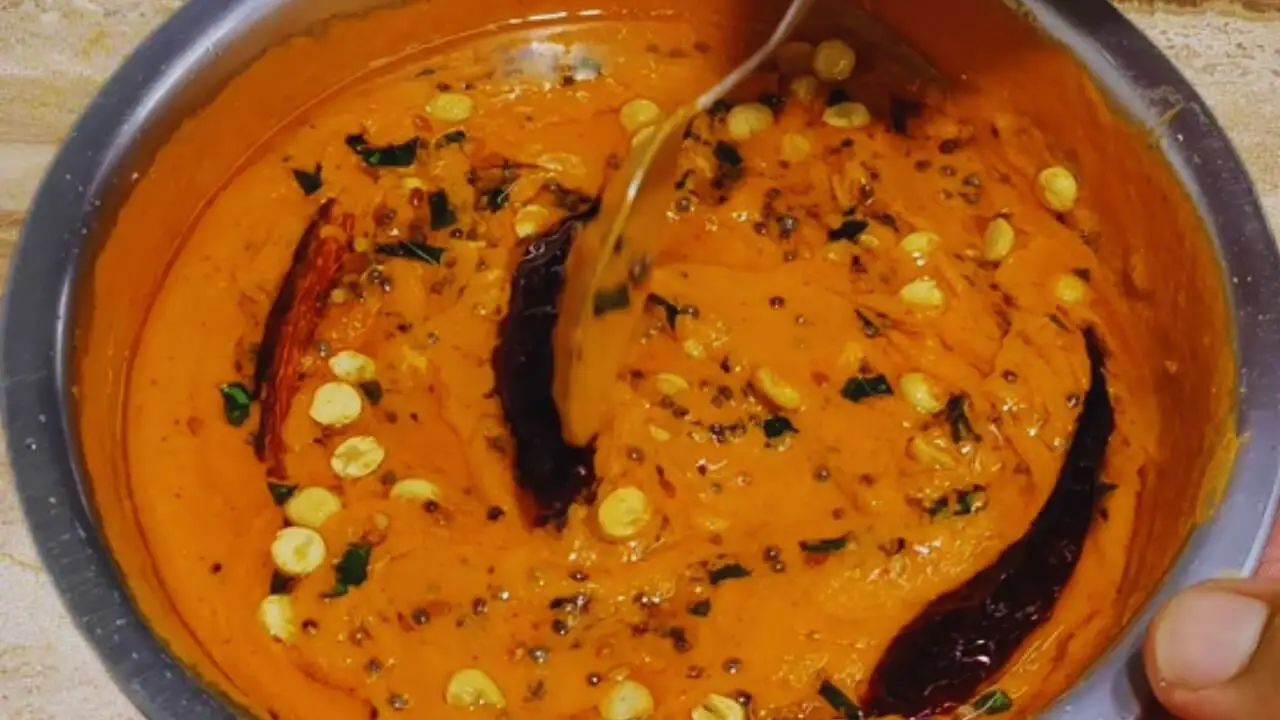
Step 31: Finally, your onion-tomato chutney is also ready to be served with dosa.
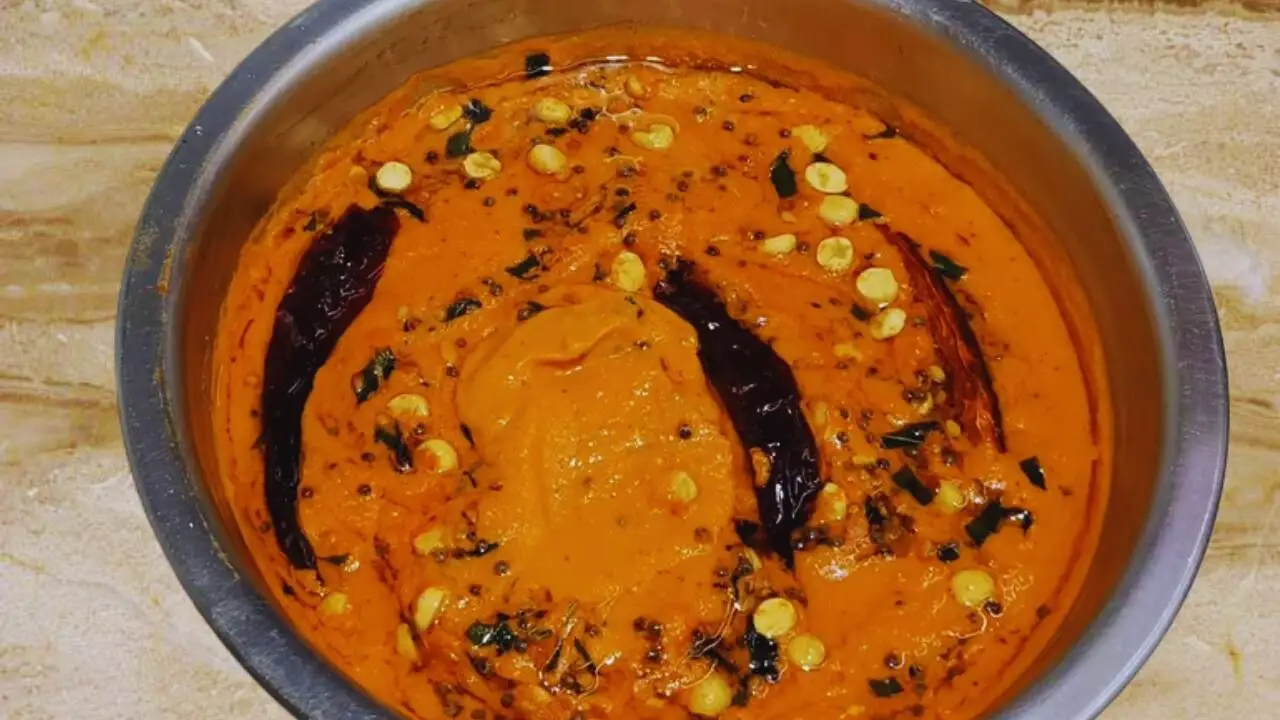
Pro Tips for Cooking Dosa Chutney
Freshness Matters: Use the freshest coconut, curry leaves, and chilies for vibrant flavors.
Perfect Texture: Grind the chutney to a fine paste for a smooth and appealing texture.
Milk Magic: Opt for warm milk to enhance the color and taste of the coconut chutney, or use water as an alternative.
Tadka Technique: Choose mustard oil for the coconut chutney tadka, adding an extra layer of flavor.
Onion Mastery: Ensure onions are cooked thoroughly to eliminate the raw taste in the onion-tomato chutney.
Chana Dal Swap: No roasted chana dal? Substitute with roasted peanuts for a similar crunch.
Minimal Water: Avoid adding excess water when blending to prevent premature spoilage of the chutney.
Crackling Caution: Be careful when mustard seeds crackle during tadka; they may splatter hot oil.
Dosa Chutney Storing Tips
Refrigeration Rules: Store both coconut and onion-tomato chutneys in airtight containers in the refrigerator.
Avoid Moisture: Ensure containers are dry before storing to prevent moisture, which can spoil the chutney.
Layer of Oil: Add a thin layer of oil on top of the chutney before refrigerating to preserve freshness.
Freeze Smartly: While coconut chutney may lose some freshness when frozen, onion-tomato chutney can be frozen for longer storage.
How Does Dosa Chutney Taste?
Coconut Chutney:
Fresh and Creamy: The coconut chutney bursts with fresh and creamy goodness, thanks to the combination of freshly grated coconut and warm milk. The result is a delightful blend that perfectly complements the crispiness of dosas.
Onion-Tomato Chutney:
Zesty and Tangy: The onion-tomato chutney offers a zesty and tangy flavor profile. The mix of tomatoes, onions, and spices creates a harmonious blend that adds a punch to your dosa. It’s a savory symphony that elevates the overall taste experience.
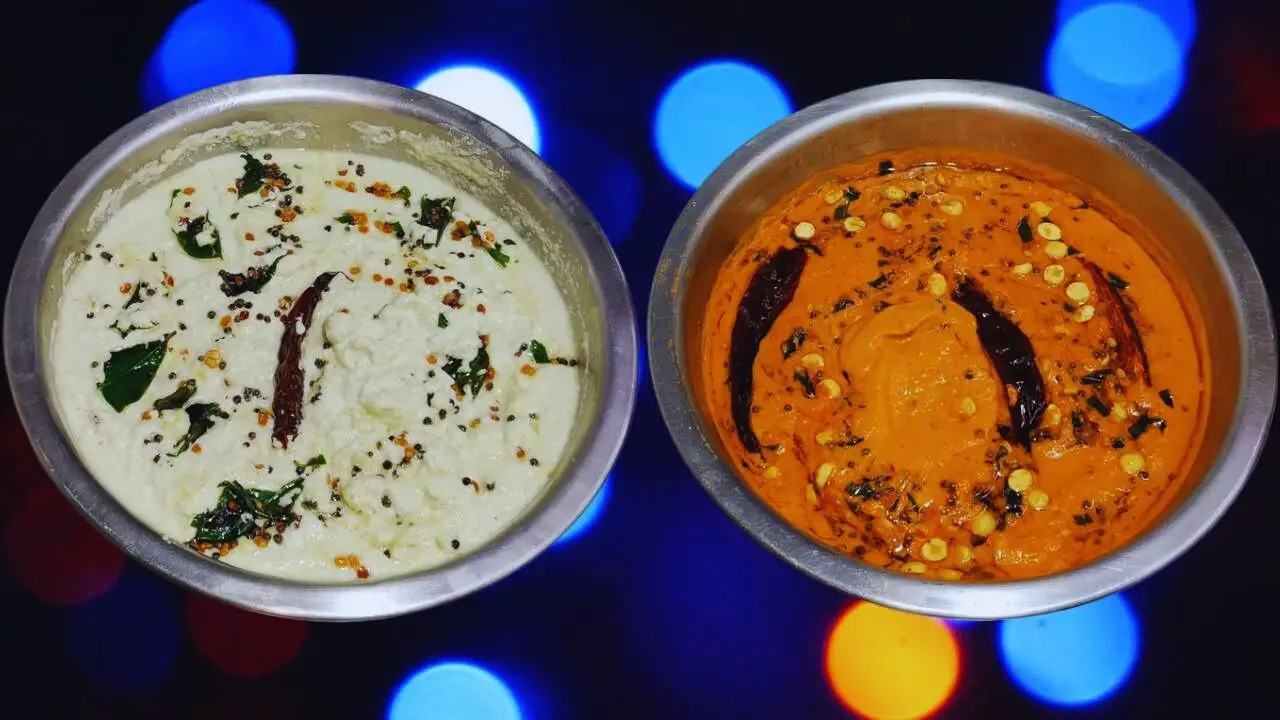
Dosa Chutney Alternatives
Mint Chutney: Swap out for a mint chutney if you’re craving a refreshing twist. The coolness of mint complements dosas exceptionally well.
Tomato-Garlic Chutney: Opt for a tomato-garlic chutney for a burst of garlicky goodness. It adds a robust flavor that pairs perfectly with dosas.
Peanut Chutney: Try a peanut chutney for a nutty delight that brings a unique crunch and earthy taste to your dosa experience.
Coriander Chutney: Experiment with coriander chutney for an herb-infused alternative. It’s light, flavorful, and complements dosas beautifully.
Tamarind Chutney: Explore the sweet and tangy notes of tamarind chutney as an alternative to add a sweet and tangy kick to your dosa journey.
What Dishes Can Dosa Chutney Be Served with?
Dosa Varieties: Enjoy coconut and onion-tomato chutneys with various dosa variations like plain dosa, masala dosa, or rava dosa.
Idli: Serve these flavorful chutneys alongside soft and fluffy idlis for a classic South Indian breakfast.
Uttapam: Elevate the taste of uttapam by pairing it with these chutneys. The savory goodness complements the mildness of uttapam.
Paniyaram: Dip paniyaram, the crispy and fluffy dumplings, into these chutneys for a delightful snack.
Vada: Enjoy the chutneys with vada, either as a side or by creating a vada-dosa sandwich for a fusion twist.
Upma: Enhance the flavors of upma by serving it with a dollop of these chutneys, adding an extra layer of taste.
Bread: Transform your breakfast by spreading these chutneys on toasted bread or using them in a sandwich for a fusion treat.
Snack Platter: Include these chutneys in your South Indian snack platter, featuring items like samosas, pakoras, or bhajis. The combination adds a burst of flavor.
Recipe Card
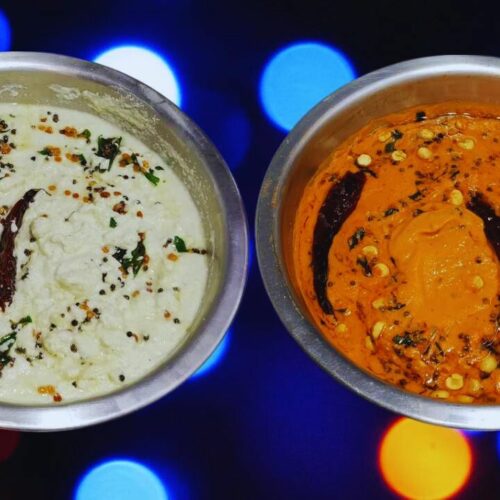
Dosa Chutney
Ingredients
For Dosa Coconut Chutney:
- 1 cup Fresh coconut (cut into small pieces)
- 25 pieces Fresh curry leaves
- 2 pieces Fresh green chilies
- 1 piece Fresh ginger 1-inch size (deskinned and sliced)
- 2 tbsp Roasted split chickpeas (chana dal)
- 2 cups Milk
- ½ tsp Normal salt
For the Tadka:
- 1 tbsp Oil
- 1 tsp Black gram lentils (urad dal) (split and deskinned)
- 1 tsp Mustard seeds
- 2 pieces Dry red chilies medium-sized
- 10 pieces Fresh curry leaves
For Dosa Onion and Tomato Chutney:
- 2 cups Tomato (cut roughly into small pieces)
- 1 cup Onion (sliced)
- 1.5 tbsp Oil
- 3 pieces Dry Kashmiri red chilies
- 5 cloves Garlic (deskinned and chopped roughly)
- 1 piece Fresh ginger 1-inch size (deskinned and chopped roughly)
- 1 tsp Mustard seeds
- 10 pieces Fresh curry leaves
- ½ tsp Table salt
- 1 tsp Kashmiri red chili powder
- 2 tbsp Roasted split chickpeas (chana dal)
For the Tadka:
- 1 tbsp Oil
- 1 tsp Black gram lentils (urad dal) (split and deskinned)
- 1 tsp Roasted split chickpeas (chana dal)
- ½ tsp Mustard seeds
- 3 pieces Dry red chilies medium-sized
- 6 pieces Fresh curry leaves (finely chopped)
Instructions
For Dosa Coconut Chutney:
- Prepare the Coconut:Break the coconut shell and remove the brown skin with a peeler. Cut the coconut into small pieces.
- Grind the Ingredients:In a grinder, add fresh coconut slices, curry leaves, green chilies, ginger slices, and roasted split chickpeas (chana dal).Optionally, add warm milk or water for blending. Milk enhances the chutney's flavor and color.
- Season with Tadka:In a pan, heat oil. Add black gram lentils (urad dal), mustard seeds, dry red chilies, and curry leaves.Let the ingredients splutter and infuse their flavors. Then pour this seasoning over the chutney paste.
- Mix and Serve:Add salt to the paste and mix thoroughly. Your flavorful coconut chutney for dosa is ready to serve.
For Dosa Onion Tomato Chutney:
- Prepare Onion and Tomato:Slice fresh onions and chop red tomatoes roughly into small pieces.
- Sauté and Cook:Heat oil in a pan. Add dry Kashmiri red chilies, garlic, ginger, mustard seeds, and curry leaves.Cook until the raw aroma softens. Then add sliced onions and cook until translucent.
- Add Tomatoes and Spices:Introduce chopped tomatoes, salt, and Kashmiri red chili powder to the pan.Stir well and cook covered on high heat until the mixture softens and the flavors blend.
- Blend and Season:Once cooled, transfer the cooked mixture to a grinder.Blend into a smooth paste. In another pan, prepare a tadka with oil, black gram lentils, mustard seeds, roasted split chickpeas, dry red chilies, and curry leaves.Pour this seasoning over the blended paste and mix thoroughly.
- Ready to Serve:Your aromatic onion-tomato chutney is now prepared to accompany your dosa delight!
Notes
Nutrition Info (Estimation Only)
Conclusion
In conclusion, embrace the joy of homemade dosa chutneys, adding a burst of flavors to your South Indian culinary adventures.
Elevate your meals with these easy-to-make, versatile delights that complement a variety of dishes.

